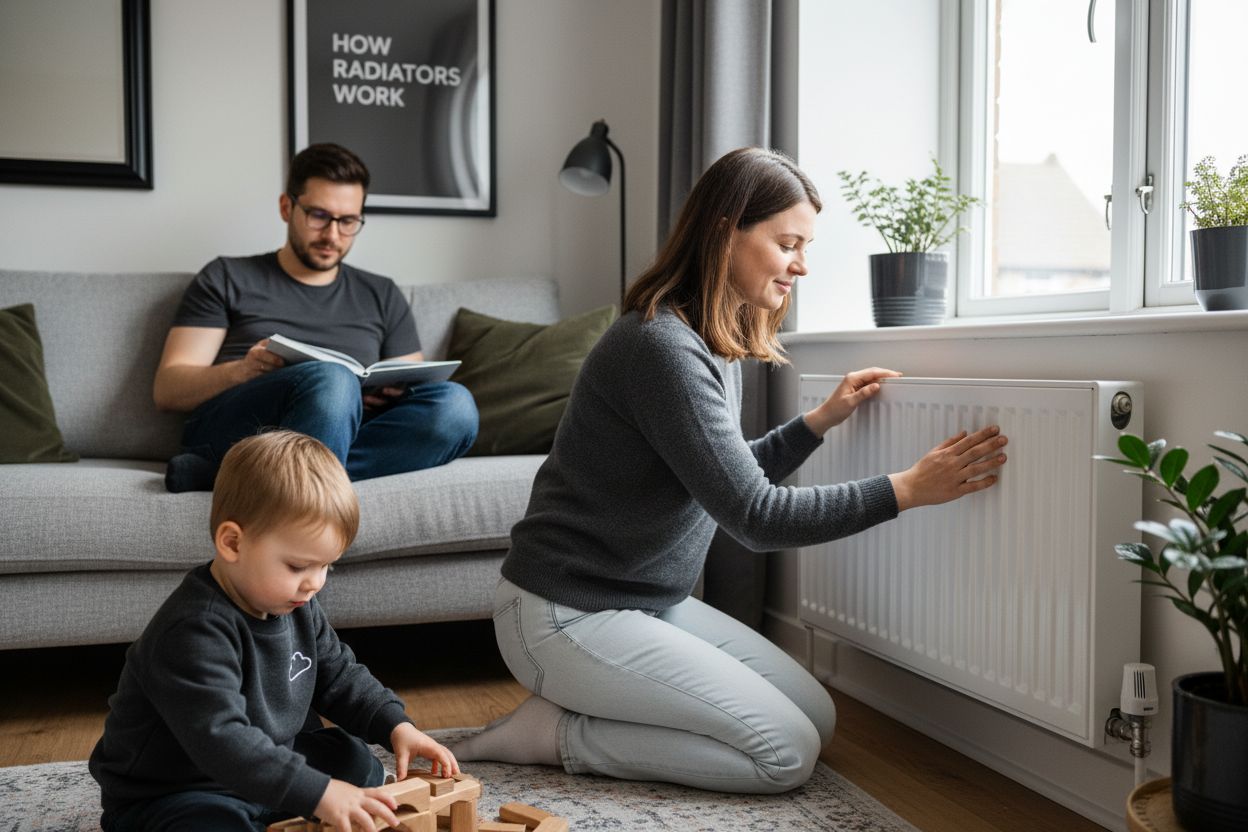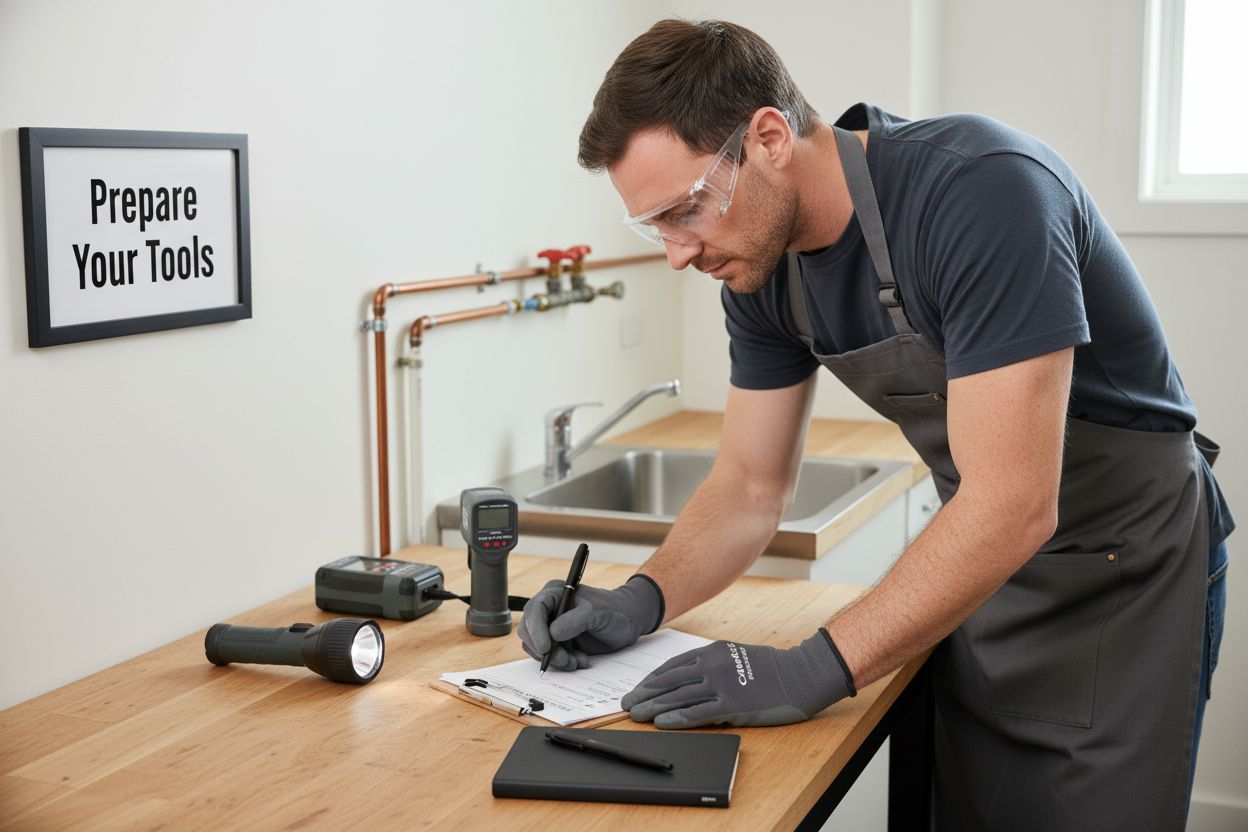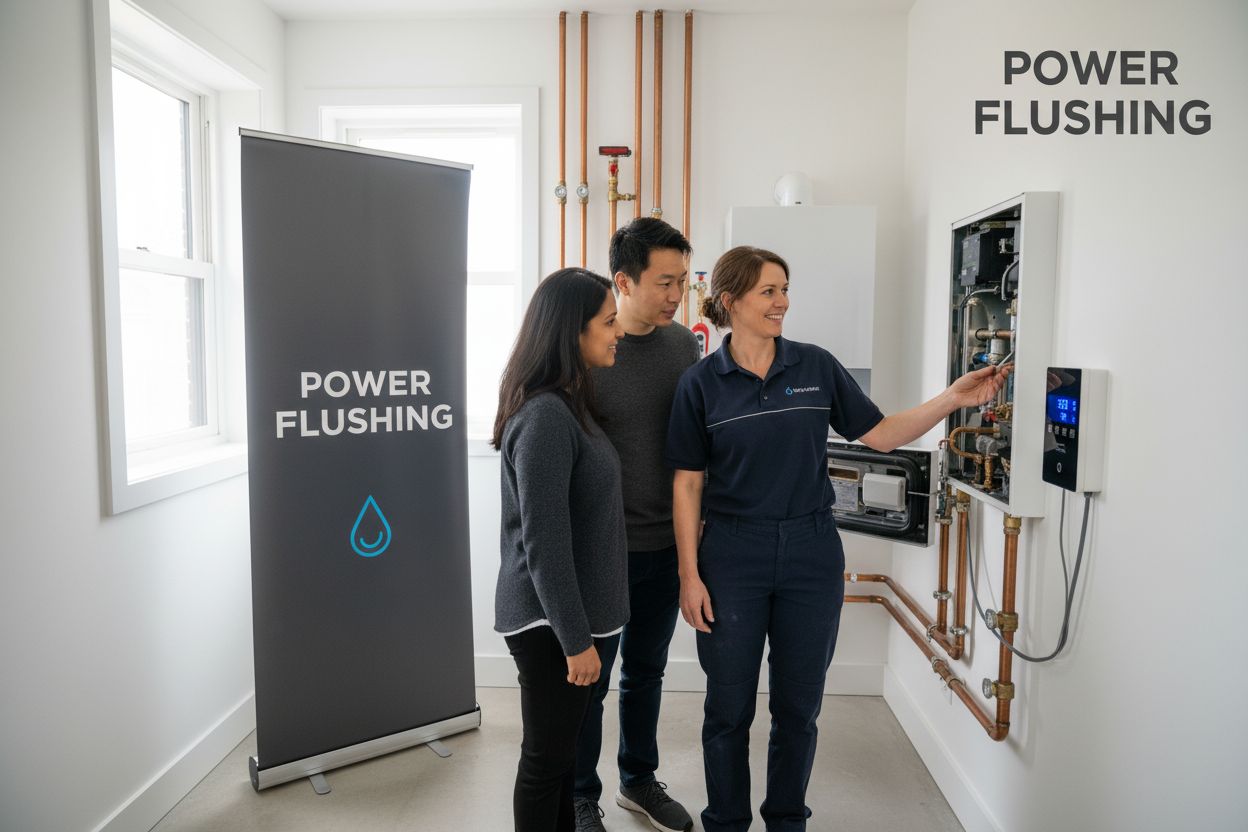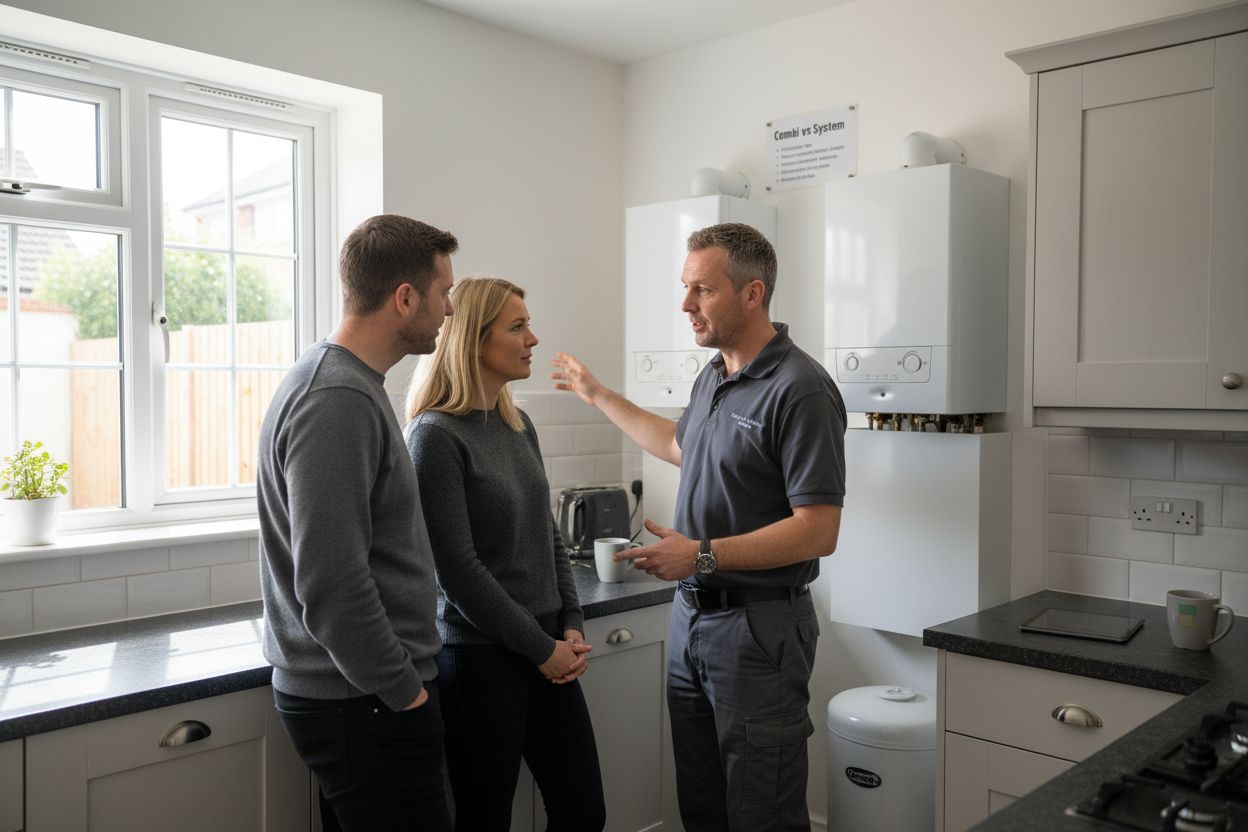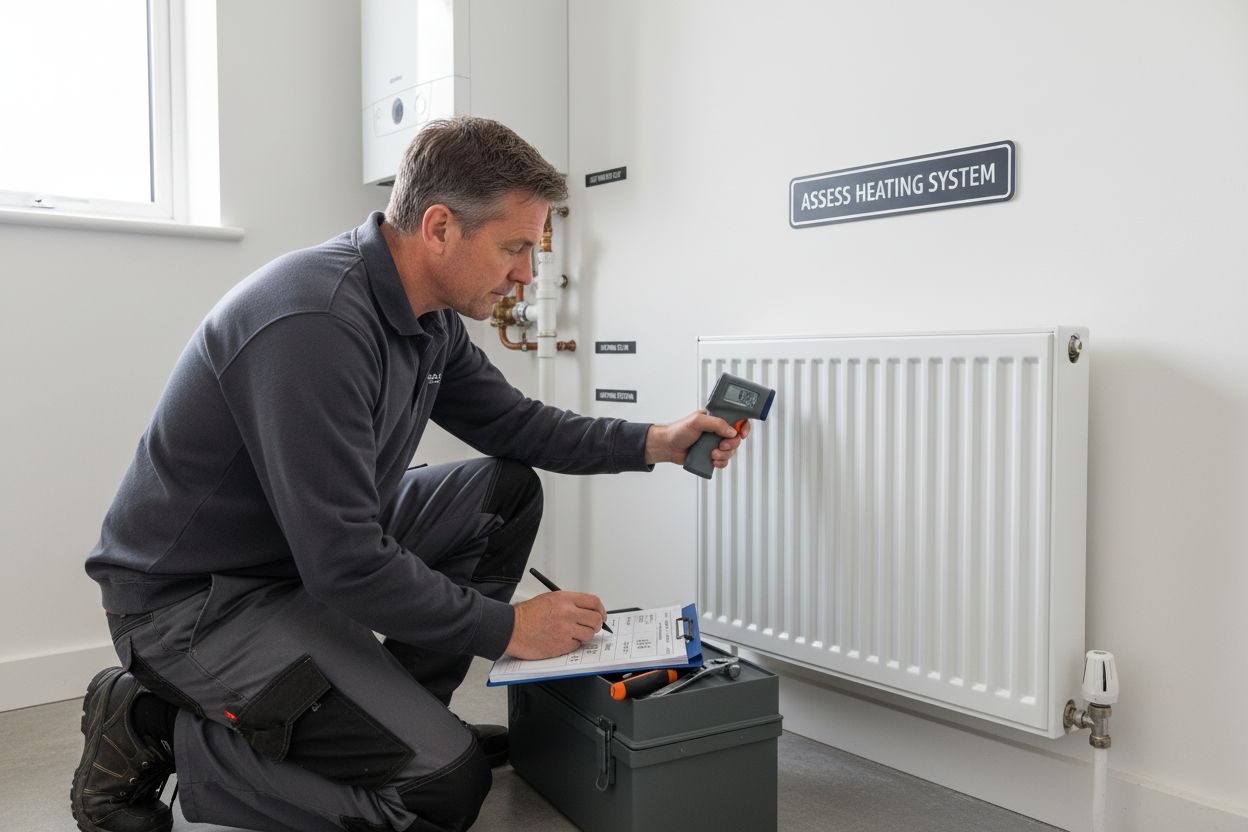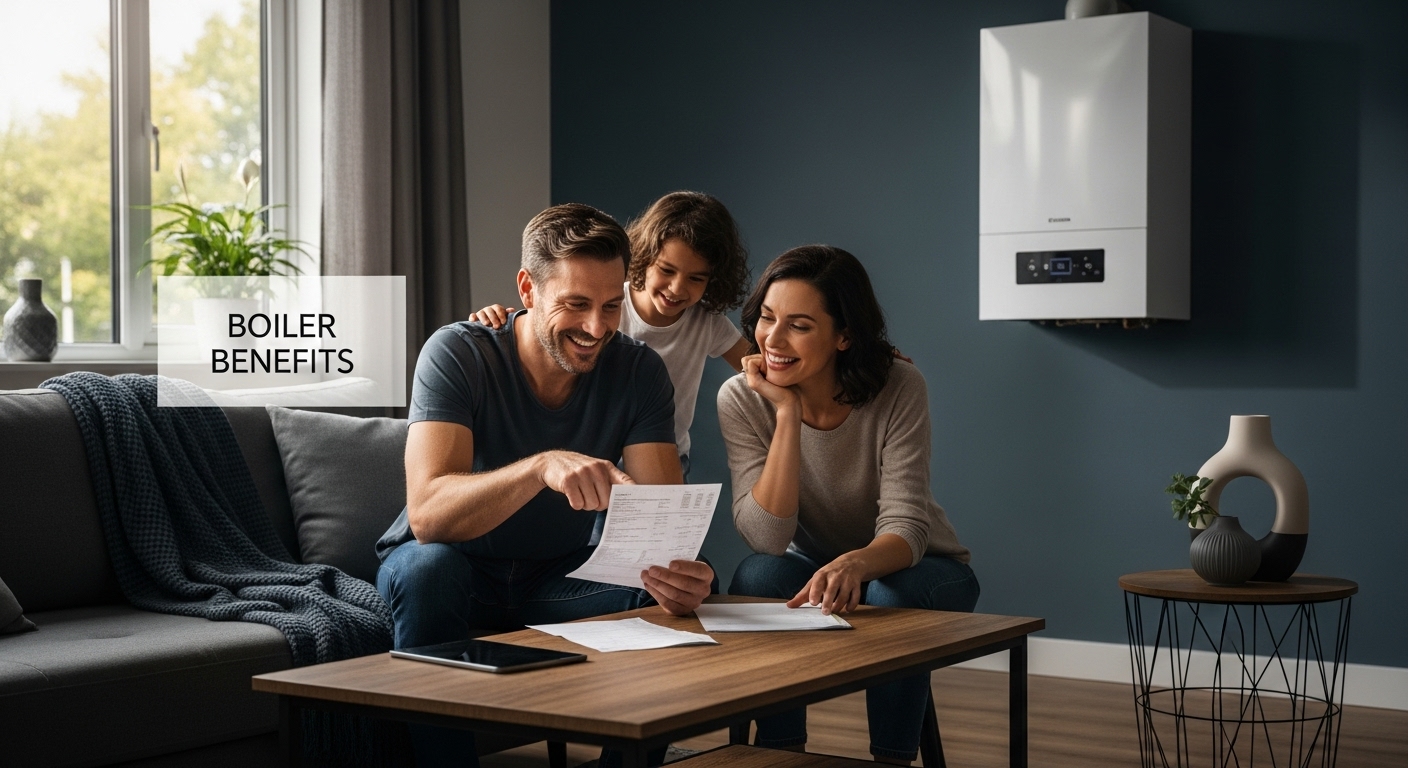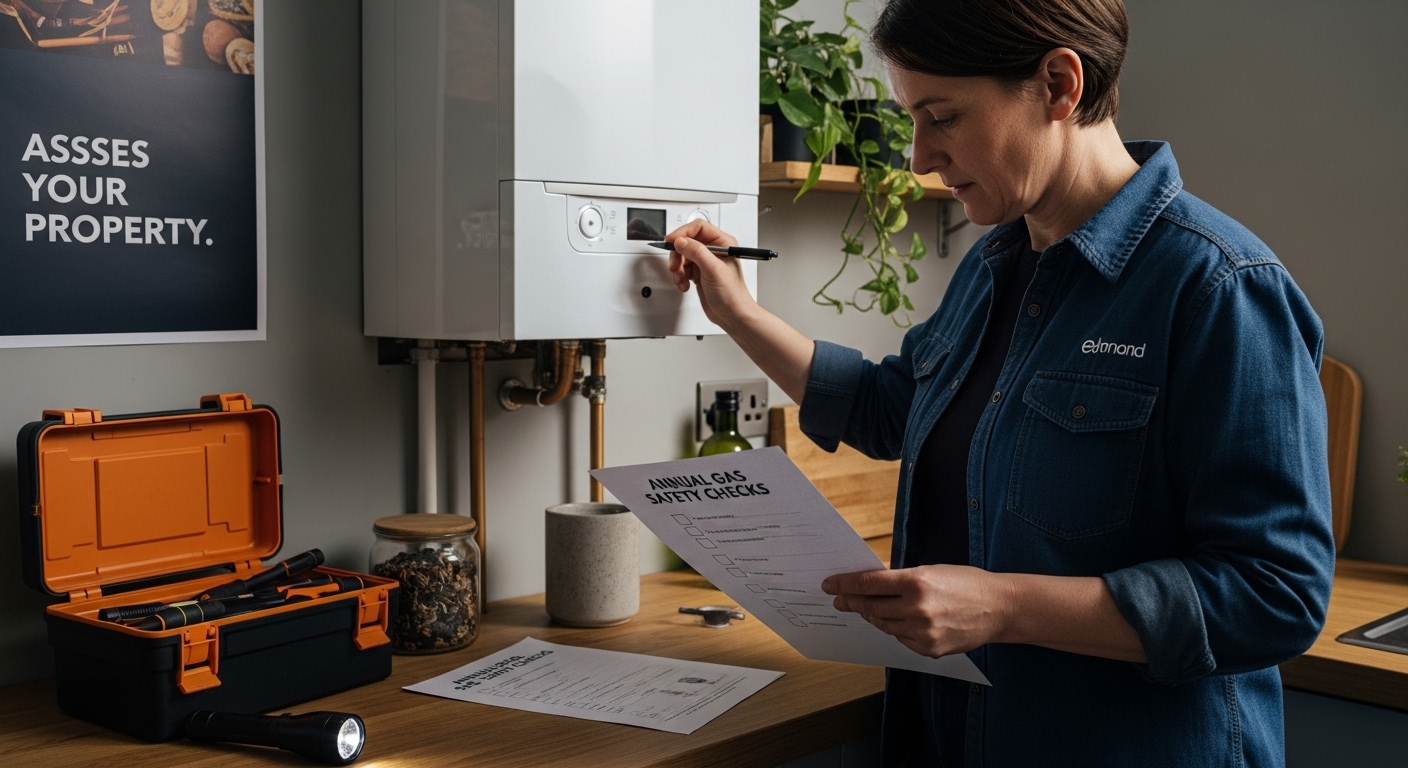Understanding How Radiators Work for Your Home
Radiators keep millions of British homes warm every winter and most people think of them as simple metal panels on the wall. Yet, modern radiators can improve home heating efficiency by up to 30% when properly installed. The surprise is that radiators do not create heat themselves at all. Instead they are quiet experts in moving and spreading warmth, not makers of it. This single difference changes how you see every radiator in your home.
Table of Contents
- What Is A Radiator And What Role Does It Play In Heating?
- Why Understanding How Radiators Work Is Important For Homeowners?
- How Do Radiators Transfer Heat Within A Space?
- Key Concepts Of Radiator Types And Their Applications
- Real-World Implications Of Radiator Efficiency And Maintenance
Quick Summary
| Takeaway | Explanation |
|---|---|
| Understanding radiators enhances energy efficiency. | Knowing how radiators work can save you 20-30% on heating bills through effective management. |
| Regular maintenance prevents costly repairs. | Early detection of issues, such as cold spots, can help avoid expensive breakdowns and extend system life. |
| Different radiator types serve distinct needs. | Choosing the right radiator material and design can optimise heating performance and accommodate your aesthetic preferences. |
| Heat transfer involves radiation, convection, and conduction. | Recognising these processes improves your ability to manage and optimise your home heating system effectively. |
| Inefficient radiators increase energy costs significantly. | Poorly maintained systems can lead to a 15% rise in energy consumption, impacting your financial expenditures. |
What is a Radiator and What Role Does it Play in Heating?
A radiator is a crucial heating device designed to transfer thermal energy from hot water or steam into surrounding living spaces, creating warmth and comfort within homes. Unlike common misconceptions, radiators do not generate heat independently but instead distribute heat efficiently through heat transfer mechanisms.
The Basic Mechanism of Heat Transfer
Radiators function on a fundamental principle of thermodynamics where heated water circulates through metal pipes and panels, releasing thermal energy into the surrounding environment. When hot water from your central heating system flows through the radiator’s internal pipework, the metal components quickly absorb and conduct this heat. Our guide on boiler functionality provides additional context about how heating systems generate this initial warmth.
The metal surfaces of radiators are strategically designed with maximum surface area to enhance heat dispersion. Typically constructed from materials like cast iron, steel, or aluminium, these surfaces rapidly warm up and radiate heat into the room through three primary methods:
- Radiation: Direct heat transmission through electromagnetic waves
- Convection: Warm air rising and circulating around the radiator
- Conduction: Heat transfer through physical contact with surrounding surfaces
Types and Functionality of Modern Radiators
Modern radiators have evolved significantly from their traditional predecessors. Contemporary designs incorporate advanced engineering principles to maximise energy efficiency and aesthetic appeal. According to research from the Energy Saving Trust, modern radiators can improve home heating efficiency by up to 30% when properly installed and maintained.
Whether you have traditional panel radiators, column radiators, or contemporary designer models, each type shares the fundamental purpose of distributing heat evenly across living spaces. Learn more about common radiator issues to understand potential challenges in maintaining optimal heating performance.
By understanding how radiators work, homeowners can make informed decisions about their heating systems, ensuring comfortable and energy-efficient home environments.
Why Understanding How Radiators Work is Important for Homeowners?
Comprehending the intricate mechanics of radiators goes beyond mere technical knowledge. It empowers homeowners to make informed decisions about their heating systems, potentially saving significant money and ensuring optimal home comfort throughout the year.
Financial and Energy Efficiency Implications
Understanding radiator functionality directly impacts household energy consumption and expenditure. Master balancing your heating systems can lead to substantial cost savings. According to research from the Energy Saving Trust, homeowners who actively manage their heating systems can reduce energy bills by up to 20-30%.
Knowledge about radiator performance enables strategic heating management through:
- Identifying potential inefficiencies in heat distribution
- Recognising when maintenance or upgrades are necessary
- Understanding optimal temperature settings for different rooms
Proactive Maintenance and Longevity
A deep understanding of radiator mechanics allows homeowners to detect potential issues before they escalate into costly repairs. Early recognition of problems such as cold spots, unusual noises, or uneven heating can prevent major system breakdowns.
Homeowners who comprehend their radiators can:
- Perform basic maintenance tasks independently
- Communicate more effectively with heating professionals
- Make informed decisions about system upgrades or replacements
By investing time in understanding how radiators work, you transform from a passive consumer into an active manager of your home’s heating infrastructure, ensuring comfort, efficiency, and long-term cost-effectiveness.
How Do Radiators Transfer Heat Within a Space?
Radiators employ sophisticated heat transfer mechanisms that transform thermal energy into comfortable living environments through three primary methods: radiation, convection, and conduction. Understanding these processes reveals how heat moves from the radiator into your living spaces.
Radiation: Direct Thermal Wave Transmission
Radiation represents the most direct heat transfer method, where thermal energy travels through electromagnetic waves directly from the radiator’s surface to surrounding objects and people. Infrared radiation allows heat to move through space without requiring physical contact, similar to how sunlight warms surfaces. Learn more about alternative heating technologies to compare different heat transfer approaches.
According to research from the Building Research Establishment, radiation can account for approximately 40% of the total heat transfer in a typical room, making it a crucial mechanism for creating warmth.
Convection: Warm Air Circulation Dynamics
Convection occurs when heated air becomes less dense and rises from the radiator, creating natural air circulation patterns. As warm air ascends, cooler air is drawn towards the radiator, creating a continuous thermal movement that gradually heats the entire space. This process ensures even heat distribution throughout rooms.
Key characteristics of convection heat transfer include:
- Warm air rising from radiator surfaces
- Cooler air being pulled towards the heat source
- Creating gentle, consistent room warming
Conduction: Direct Surface Heat Transfer
Conduction involves direct heat transfer through physical contact between the radiator and surrounding surfaces like walls, furniture, and flooring. Metal radiators with high thermal conductivity quickly absorb heat from hot water and transfer it to nearby objects, creating secondary warming effects.
By understanding these intricate heat transfer mechanisms, homeowners can optimise their heating systems, ensuring efficient and comfortable indoor environments. The interplay of radiation, convection, and conduction transforms a simple metal device into a sophisticated thermal management tool.
Below is a comparison of the three primary heat transfer mechanisms used by radiators, summarising their processes and key contributions to home heating.
| Heat Transfer Method | Description | Contribution to Room Heating |
|---|---|---|
| Radiation | Transfer of heat via electromagnetic (infrared) waves | Directly warms objects and occupants in the room |
| Convection | Circulation of warm air rising and cool air being drawn in | Ensures even heat distribution throughout the room |
| Conduction | Heat transfer through physical contact with surfaces | Warms adjacent walls, floors, or furniture |
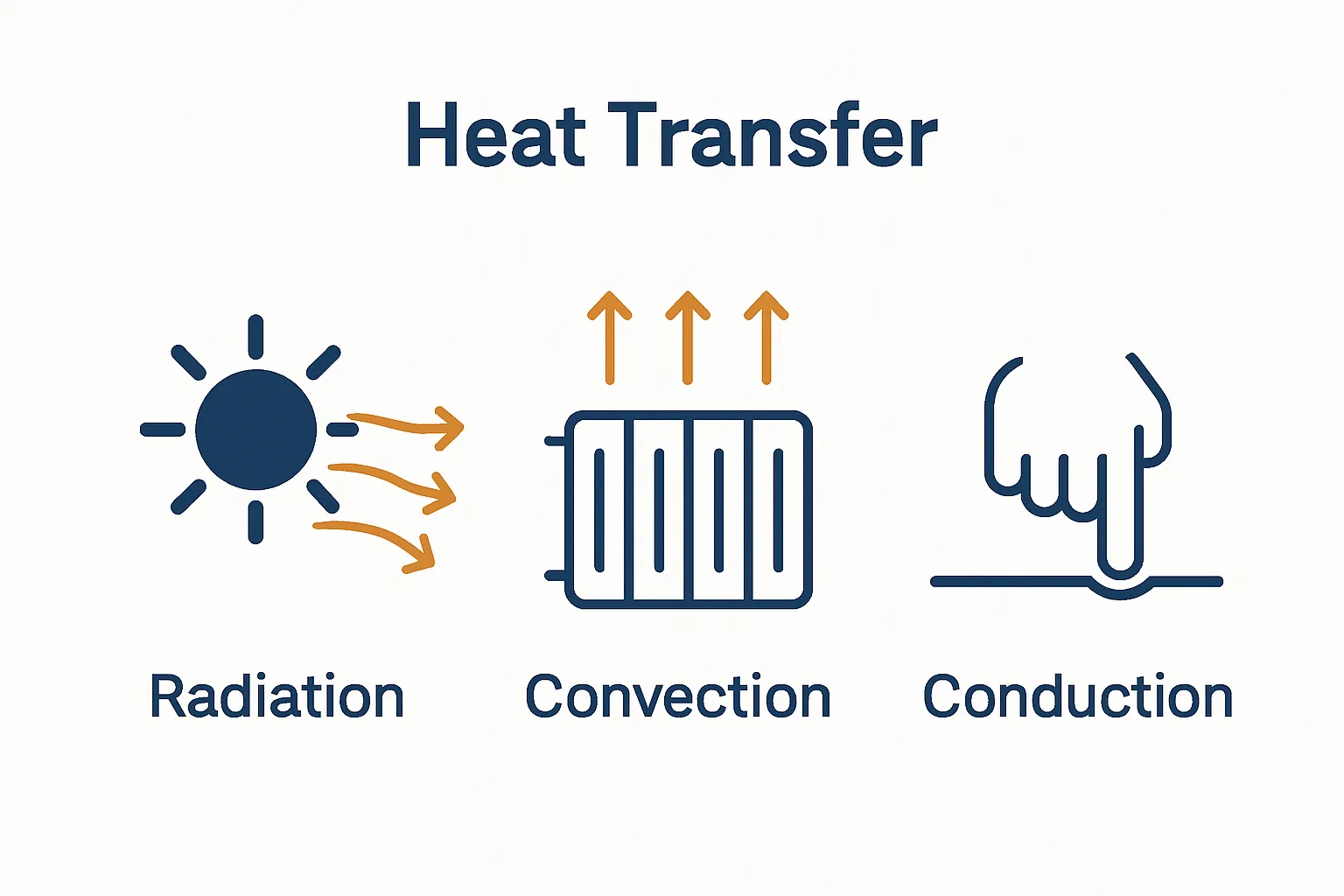
Key Concepts of Radiator Types and Their Applications
Radiator technology has evolved significantly, offering diverse designs tailored to specific heating requirements and aesthetic preferences. Understanding the nuanced characteristics of different radiator types enables homeowners to make informed decisions about their heating infrastructure.
Traditional Panel Radiators: Versatile Heating Solutions
Panel radiators represent the most common heating method in residential properties. Characterised by their flat, rectangular design, these radiators efficiently distribute heat through convection and radiation. Explore alternative heating technologies to compare different warming approaches.
According to research from the Heating and Hot Water Council, panel radiators remain the most prevalent heating solution in UK households, offering:
- Cost-effective installation
- Flexible sizing options
- Straightforward maintenance
- Compatibility with most central heating systems
Specialist Radiator Designs: Performance and Aesthetics
Beyond traditional panels, contemporary radiator designs cater to specific functional and decorative requirements. Column radiators, featuring multiple vertical pipes, provide enhanced heat distribution and a classic architectural aesthetic. Designer radiators transform heating elements from purely functional devices into statement pieces that complement interior design.
Specialist radiator types include:
- Vertical radiators maximising wall space in compact rooms
- Aluminium radiators offering rapid heat response
- Towel radiators combining heating with practical bathroom functionality
Material Considerations and Thermal Performance
The material composition significantly influences a radiator’s thermal efficiency and durability. Cast iron radiators retain heat exceptionally well but warm slowly, while aluminium radiators offer rapid heating and lightweight construction. Steel remains a popular middle-ground option, balancing performance and affordability.
By understanding these radiator variations, homeowners can select heating solutions that precisely match their spatial, aesthetic, and thermal requirements, ensuring optimal comfort and energy efficiency.
The following table organises distinctive types of radiators, highlighting their primary features and typical applications to assist homeowners in making informed decisions for their heating needs.
| Radiator Type | Key Features | Typical Applications |
|---|---|---|
| Panel Radiator | Flat, rectangular, efficient, widespread use | Most UK domestic properties, living areas, bedrooms |
| Column Radiator | Multiple vertical columns, classic appearance | Heritage homes, period properties, style-focused rooms |
| Designer Radiator | Contemporary shapes/finishes, decorative appeal | Modern interiors, feature walls |
| Vertical Radiator | Tall, narrow design, space-saving | Small or narrow spaces, kitchens, hallways |
| Towel Radiator | Rails for drying towels, combines heating and utility | Bathrooms, en suites |
| Aluminium Radiator | Lightweight, rapid heat response | Energy-efficient upgrades, rooms needing fast warmth |
| Cast Iron Radiator | Heavy, high heat retention, traditional look | Older homes, rooms requiring sustained heat |
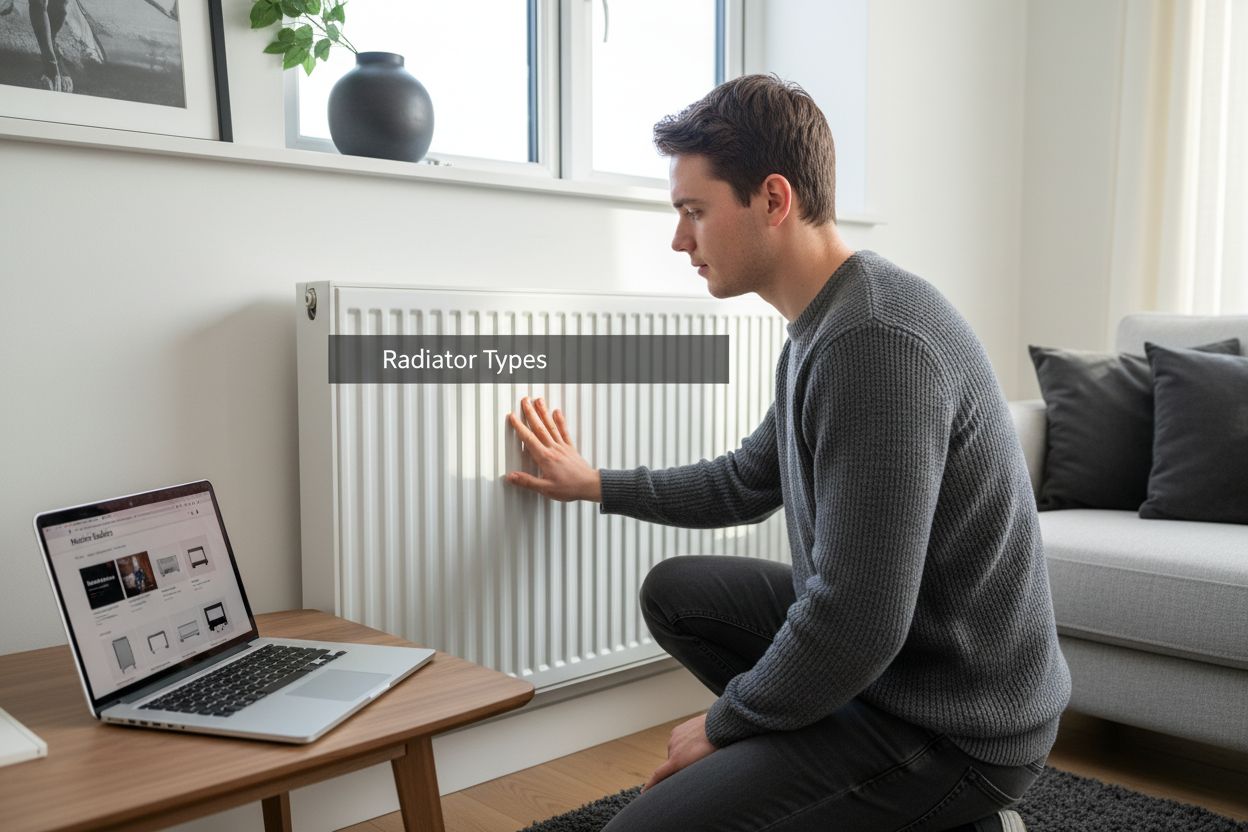
Real-World Implications of Radiator Efficiency and Maintenance
Radiator performance extends far beyond theoretical concepts, directly impacting household energy consumption, comfort, and long-term financial expenditure. Understanding the practical dimensions of radiator efficiency transforms heating from a passive utility to an actively managed home system.
Economic Impact of Radiator Performance
Inefficient radiators can significantly escalate household energy expenses, creating unnecessary financial strain. Explore strategies for energy-efficient heating to optimise your home’s thermal management. According to research from the Energy Saving Trust, poorly maintained radiators can increase energy consumption by up to 15%, translating to substantial annual costs.
Key economic considerations include:
- Potential energy bill reductions through regular maintenance
- Long-term savings from proactive system management
- Avoiding costly emergency repairs through preventative care
Performance Degradation and System Health
Radiators accumulate sediment, air pockets, and mineral deposits over time, which compromise their heating efficiency. Sludge buildup can create uneven heat distribution, cold spots, and increased strain on your central heating system. Professional interventions like power flushing can restore radiator performance and extend system lifespan.
Common performance indicators suggesting maintenance requirements:
- Inconsistent room temperatures
- Unusual noises during heating cycles
- Radiators taking longer to warm up
- Visible corrosion or leakage
Environmental and Comfort Considerations
Beyond economic factors, radiator efficiency directly influences home comfort and environmental sustainability. Well-maintained radiators ensure consistent thermal environments while reducing unnecessary energy consumption. Efficient heating systems contribute to lower carbon emissions, supporting broader climate protection goals.
By recognising radiators as dynamic systems requiring periodic attention, homeowners can achieve optimal thermal comfort, minimise energy waste, and maintain a responsive, efficient heating infrastructure.
Unlock Lasting Comfort with Expert Radiator Solutions
Understanding problems like uneven heat, cold spots or rising bills is only the first step. The article highlighted how poor radiator performance can quickly disrupt comfort, waste energy and cause unnecessary expenses. If you have noticed issues with heat transfer or want to make sure your system runs efficiently year-round, now is the time to act. Our Gas Safe Registered engineers use advanced methods like power flushing and bespoke system upgrades to restore and maintain the best possible performance.
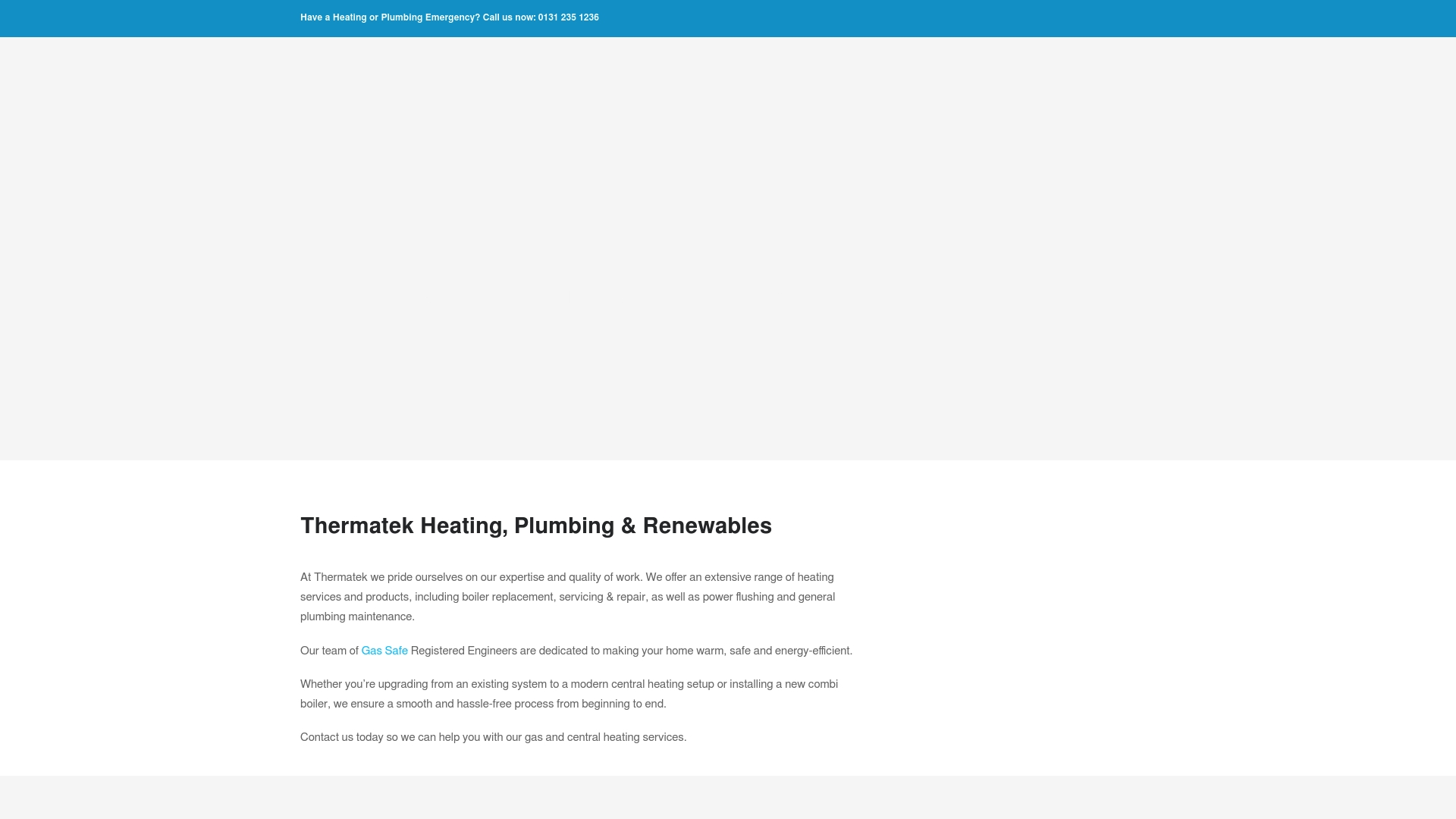
Let Thermatek bring reliable warmth and energy savings to your home. For confident help with your heating system, including repair, maintenance and full upgrades, visit our main website and request your free personalised quote. Secure professional advice and trusted service so you can enjoy efficient, worry-free heating from now on.
Frequently Asked Questions
How do radiators transfer heat in a room?
Radiators transfer heat through three primary mechanisms: radiation, convection, and conduction. Radiation involves direct thermal wave transmission, convection circulates warm air, and conduction transfers heat through physical contact with surrounding surfaces.
What types of radiators are available for home heating?
There are several types of radiators, including traditional panel radiators, column radiators, and designer models. Each type has its own unique features and aesthetic appeal, catering to different heating needs and interior designs.
Why is proper maintenance of radiators important?
Proper maintenance of radiators helps prevent inefficiencies such as cold spots and uneven heating. Regular care can also reduce energy bills, extend the lifespan of the heating system, and ensure optimal comfort within the home.
What are the benefits of understanding how radiators work?
Understanding radiator functionality allows homeowners to manage heating systems effectively, identify inefficiencies, perform basic maintenance, and make informed decisions about potential upgrades or replacements.
Recommended
- 7 Common Radiator Problems And How To Fix Them - Thermatek Heating
- Understanding How Does A Boiler Work For Heating - Thermatek Heating
- Master Balancing Heating Systems For Optimal Comfort - Thermatek Heating
- 7 Key Underfloor Heating Pros And Cons To Consider - Thermatek Heating
Understanding Energy Efficient Heating for Your Home
Energy efficient heating sounds simple on the surface. Everyone wants a warm home without sky-high bills, and the promise is hard to ignore. But here’s a surprise. Heating accounts for nearly 14 percent of all UK carbon emissions and slashing energy use can cut household bills by up to 40 percent. Most people think the main benefit is saving money, but the bigger impact is how much it protects the environment. That changes everything.
Table of Contents
- What Is Energy Efficient Heating?
- Why Energy Efficient Heating Matters
- How Energy Efficient Heating Works
- Key Concepts Of Energy Efficient Heating
Quick Summary
| Takeaway | Explanation |
|---|---|
| Energy efficient heating reduces bills by up to 40%. | Efficient heating technologies can significantly lower household energy expenses, providing immediate financial relief. |
| Advanced systems improve thermal comfort and reduce waste. | Technologies like heat pumps and smart controls optimise heat generation and distribution, ensuring minimal energy waste and maximum comfort. |
| Implementation supports environmental sustainability. | Using energy efficient heating reduces carbon emissions and reliance on non-renewable resources, benefiting the environment and contributing to climate goals. |
| Home value may increase with energy-efficient systems. | Properties equipped with high-efficiency heating can fetch higher market valuations, making them attractive investments for homeowners. |
| Government incentives can enhance economic benefits. | Many governments offer financial incentives for energy-efficient upgrades, making adoption more appealing from a financial standpoint. |
What is Energy Efficient Heating?
Energy efficient heating represents a strategic approach to warming homes while minimising energy consumption and reducing environmental impact. It focuses on technologies and methods that provide maximum thermal comfort using minimal energy resources. Learn more about our renewable heating solutions.
Understanding the Core Principles
At its fundamental level, energy efficient heating involves intelligent systems that generate, distribute, and maintain heat with superior performance compared to traditional heating methods. According to Energy Saving Trust, efficient heating can reduce household energy bills by up to 40% while significantly lowering carbon emissions.
The primary objectives of energy efficient heating include:
- Minimising heat loss through superior insulation
- Utilising advanced heating technologies
- Optimising temperature control and distribution
- Reducing overall energy consumption
Technology and Mechanisms
Modern energy efficient heating relies on sophisticated technologies like heat pumps, condensing boilers, and smart thermostatic controls. These systems work by capturing, transferring, and maintaining heat with unprecedented precision. They employ advanced sensors, variable speed components, and intelligent programming to adapt heating output based on real-time environmental conditions and household requirements.
By integrating renewable energy sources and high-efficiency equipment, homeowners can achieve substantial energy savings while maintaining consistent indoor comfort levels.
To clarify the various technologies implemented in energy efficient heating systems, the following table contrasts their main features and advantages as mentioned in the article.
| Technology | Key Features | Advantages |
|---|---|---|
| Heat Pumps | Capture and transfer ambient heat | Highly efficient, lower emissions |
| Condensing Boilers | Recover heat from exhaust gases | Improved efficiency, lower costs |
| Smart Thermostatic Controls | Use sensors and intelligent programming | Precision control, reduced waste |
| Renewable Energy Integration | Utilises sources like solar power | Minimises reliance on fossil fuels |
| The goal is not merely to generate heat, but to do so with minimal waste and maximum effectiveness. |
Why Energy Efficient Heating Matters
Energy efficient heating transcends mere technological innovation it represents a critical strategy for environmental sustainability, economic savings, and improved quality of life. Explore our solar thermal solutions to understand how renewable technologies contribute to this important mission.
Environmental Impact
The significance of energy efficient heating becomes starkly apparent when examining its environmental consequences. According to UK Government Climate Change Report, residential heating contributes approximately 14% of total UK carbon emissions. By adopting energy efficient heating technologies, homeowners can dramatically reduce their carbon footprint and contribute meaningfully to national and global climate objectives.
Key environmental benefits include:
- Reduced greenhouse gas emissions
- Lower consumption of non renewable energy resources
- Minimised ecological disruption from traditional energy production
- Support for sustainable infrastructure development
Economic Considerations
Beyond environmental advantages, energy efficient heating offers substantial economic benefits for households and businesses. Investing in high performance heating systems represents a strategic financial decision that generates long term savings. Modern energy efficient technologies can reduce heating expenses by up to 40%, providing significant relief for household budgets.
The economic rationale extends beyond immediate cost savings.
The table below summarises key environmental and economic impacts of adopting energy efficient heating, helping to distinguish why both aspects are critical for households.
| Impact Area | Main Benefits |
|---|---|
| Environmental | Reduced greenhouse emissions, supports sustainability |
| Economic | Up to 40% reduction in energy bills, higher home value |
| Resource Consumption | Lower use of non-renewable energy resources |
| Government Incentive | Eligibility for financial support and tax rebates |
| Homes with superior energy efficiency typically command higher market valuations, presenting an attractive proposition for property owners looking to enhance their real estate investments. |
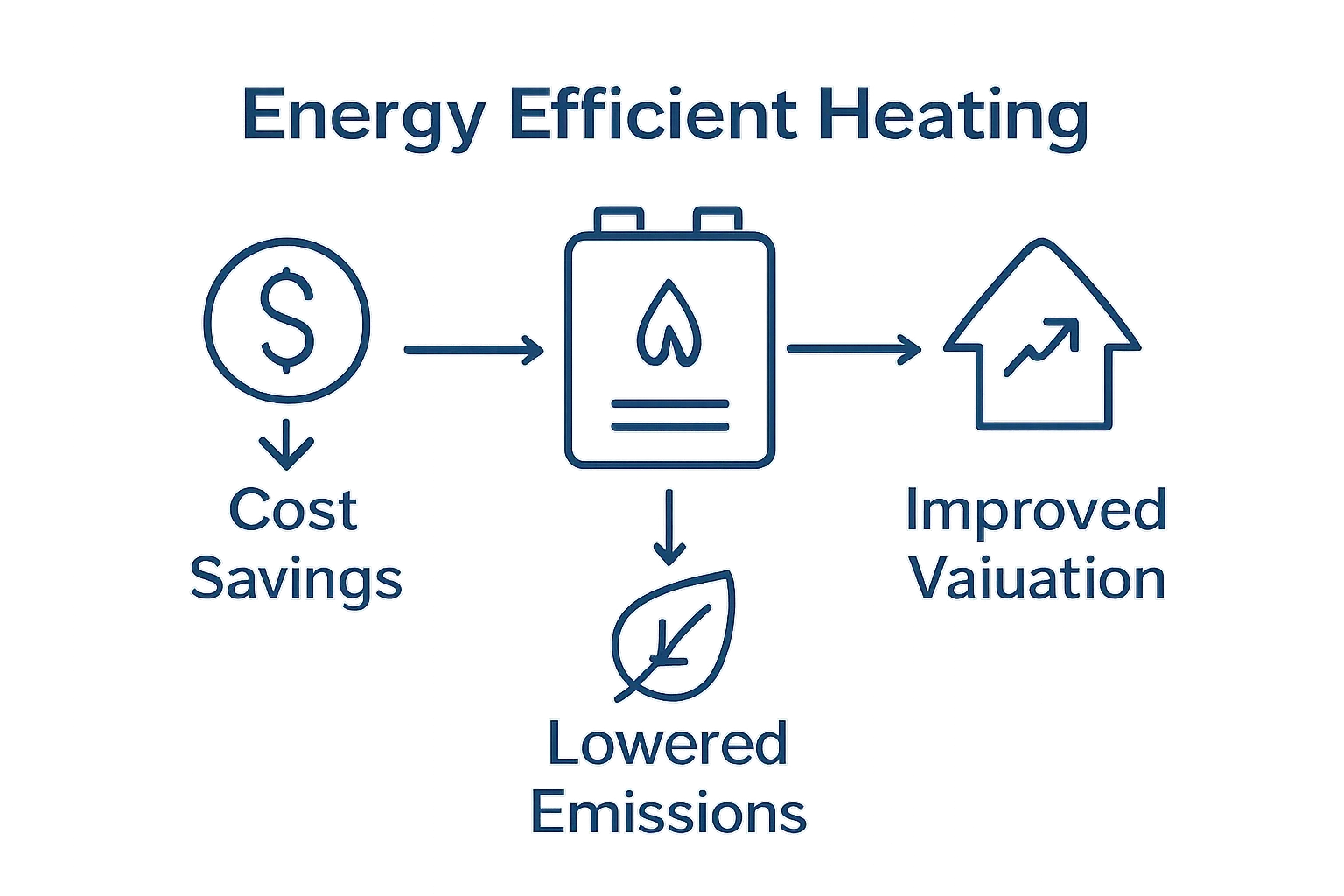 Moreover, many governments offer financial incentives and tax rebates for implementing energy efficient heating solutions, further improving the financial attractiveness of such upgrades.
Moreover, many governments offer financial incentives and tax rebates for implementing energy efficient heating solutions, further improving the financial attractiveness of such upgrades.
How Energy Efficient Heating Works
Energy efficient heating operates through sophisticated mechanisms that prioritise intelligent energy management and precise thermal control. Stay updated with our latest heating technologies to understand cutting edge developments in this dynamic field.
Heat Generation and Transfer
The core principle of energy efficient heating revolves around minimising energy waste during heat production and distribution. According to International Energy Agency, modern heating systems achieve efficiency through advanced technologies that capture, convert, and distribute heat with unprecedented precision.
Key mechanisms of heat generation include:
- Capturing ambient heat from external sources
- Converting energy with minimal thermal loss
- Utilising renewable energy inputs
- Implementing intelligent temperature regulation
Smart Control and Monitoring
Modern energy efficient heating systems leverage intelligent controls and sensor technologies to optimise performance. These systems continuously analyse environmental conditions, occupancy patterns, and thermal requirements to adjust heating output dynamically.
Advanced thermostatic controls can learn household temperature preferences, automatically modulating energy consumption to maintain optimal comfort while minimising unnecessary heating.
Technological innovations like zoned heating, predictive programming, and remote monitoring enable homeowners to achieve granular control over their heating infrastructure. By integrating sophisticated sensors and machine learning algorithms, these systems can predict and respond to heating needs with remarkable accuracy, ensuring consistent comfort while dramatically reducing energy consumption.
Key Concepts of Energy Efficient Heating
Understanding the fundamental principles underlying energy efficient heating requires a comprehensive exploration of interconnected technological and environmental strategies. Learn more about our renewable energy approaches and how they transform residential heating solutions.
Thermal Performance and Insulation
Thermal performance represents the cornerstone of energy efficient heating, focusing on minimising heat loss and maximising energy utilisation. According to Building Research Establishment, effective insulation can reduce heat loss by up to 60%, dramatically improving overall heating system efficiency.
Critical aspects of thermal performance include:
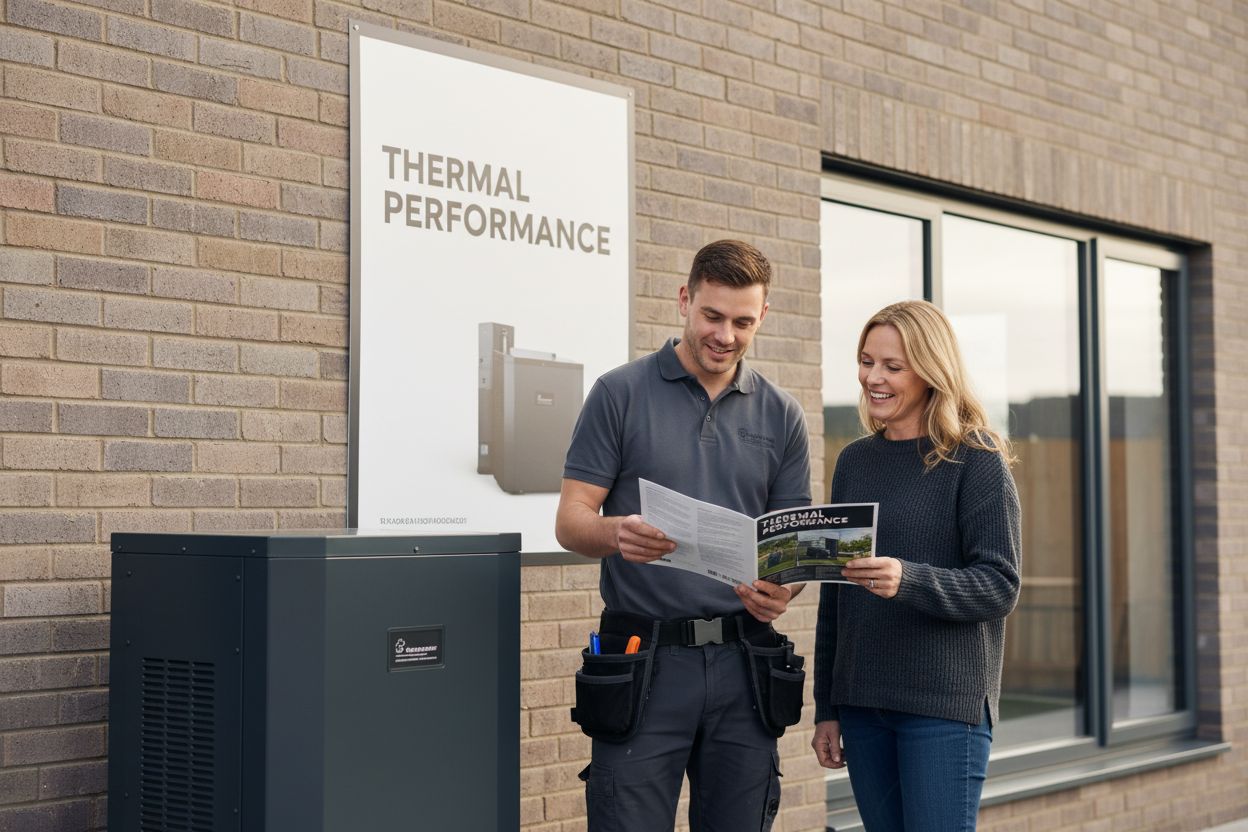
- Comprehensive building envelope protection
- Advanced insulation materials and techniques
- Minimising thermal bridges and heat transmission points
- Strategic architectural design for heat retention
Energy Conversion and Efficiency Metrics
Energy efficient heating systems are evaluated through sophisticated performance metrics that measure their capacity to convert input energy into usable heat. The primary metric, Coefficient of Performance (COP), represents the ratio of heat output to energy input, with higher values indicating superior system efficiency.
Modern heating technologies aim to achieve progressively higher efficiency ratings by implementing innovative strategies such as heat pump technologies, condensing boiler systems, and renewable energy integration. These approaches transform traditional heating paradigms, shifting from simple heat generation to intelligent, adaptive thermal management that responds dynamically to changing environmental and occupancy conditions.
The following table defines key terms frequently used in the context of energy efficient heating, making it easier to understand the core concepts addressed in the article.
| Term | Definition |
|---|---|
| Coefficient of Performance (COP) | Measure of energy efficiency: heat output divided by energy input |
| Thermal Performance | Ability of a building to retain heat and minimise loss |
| Insulation | Materials and methods used to reduce heat escape from buildings |
| Zoned Heating | Dividing property into separate heating zones with individual control |
| Smart Controls | Automated systems that regulate heating based on occupancy and demand |
Ready to Experience Real Energy Efficient Heating in Your Home?
Have you had enough of wasted energy and rising bills caused by older, inefficient heating systems? The article above explains the core ideas behind energy efficient heating, from smart controls and heat pumps to better insulation and reduced environmental impact. If you want to enjoy tangible savings, enhanced comfort, and peace of mind knowing your home is using energy responsibly, now is the perfect time to act. See how the trusted experts at Thermatek Heating can deliver reliable solutions built around your needs.

Take the next step with a free quote or speak to our Gas Safe Registered engineers for tailored advice. Whether you need a boiler replacement, smart thermostat, or a full renewable energy upgrade, we offer proven installations and ongoing support that give you control over your comfort and costs. Visit our main site now to transform your household heating and join others in Edinburgh and Midlothian switching to efficient, future-proof systems.
Frequently Asked Questions
What is energy efficient heating?
Energy efficient heating involves methods and technologies that provide effective warmth while minimising energy consumption and reducing environmental impact.
How does energy efficient heating save on energy bills?
Energy efficient heating can reduce household energy bills by up to 40% by optimising energy use through advanced technologies and improved insulation.
What technologies are used in energy efficient heating systems?
Modern systems include heat pumps, condensing boilers, and smart thermostatic controls that optimise heating output and minimise energy waste through advanced sensors and programming.
Why is insulation important for energy efficient heating?
Effective insulation minimises heat loss, which is crucial for improving overall heating system efficiency and maintaining consistent indoor temperatures.
Recommended
- News - Thermatek Heating
- Air Source Heat Pump Installation In Edinburgh - Thermatek Heating
- Solar Thermal Installers In Edinburgh - Thermatek Heating
- Central Heating Power Flushing In Edinburgh - Thermatek Heating
How to Detect Leaks: A Step-by-Step Guide for Homeowners
Most homeowners miss the warning signs of leaks until water stains or a musty smell make them impossible to ignore. Yet more than one in ten UK households will suffer a major water leak this year, turning a minor issue into thousands of pounds in damage. The real shock is that many leaks start with clues you can spot—if you know where to look and what to listen for.
Table of Contents
- Step 1: Prepare Your Tools And Environment
- Step 2: Inspect Visible Pipes And Fixtures
- Step 3: Check For Water Stains And Dampness
- Step 4: Conduct A Water Meter Tests
- Step 5: Use Leak Detection Equipment If Necessary
- Step 6: Verify And Document Findings
Quick Summary
| Key Point | Explanation |
|---|---|
| 1. Prioritise Personal Safety | Always wear protective gear and ensure good ventilation when checking for leaks, especially gas leaks, to avoid dangerous situations. |
| 2. Thoroughly Inspect Visible Areas | Check under sinks, around toilets, and exposed pipes for water damage signs like rust, stains, or moisture rings, which indicate hidden leaks. |
| 3. Conduct Water Meter Tests | Turn off all water use, record the meter reading, and check for movement after 30-45 minutes to detect hidden leaks in your plumbing. |
| 4. Use Advanced Leak Detection Tools | If needed, employ thermal cameras and acoustic devices to locate hidden leaks that are not visible during standard inspections. |
| 5. Document Findings Meticulously | Keep detailed records and photos of suspicious areas and moisture issues to provide critical information if professional help is needed later. |
Step 1: Prepare Your Tools and Environment
Detecting leaks requires careful preparation and the right equipment. Before diving into the actual leak detection process, gathering the necessary tools and creating a safe working environment will significantly improve your chances of successfully identifying and addressing potential water or gas leaks in your home.
To begin, you will need a comprehensive toolkit that supports thorough leak investigation. Essential tools for leak detection include:
- Moisture metre
- Infrared thermal camera
- Pressure testing equipment
- Adjustable wrench
- Flashlight
- Protective gloves
- Safety goggles
- Notebook for documenting findings
Safety represents the most critical component of your preparation. Always prioritise personal protection and ensure proper ventilation when investigating potential leaks. If you suspect a gas leak, immediately evacuate the area and contact professional services. Your personal safety far outweighs any potential property damage.
Prepare your workspace by clearing the area around potential leak sites. Remove furniture, carpets, or other obstructions that might impede your investigation. Good visibility and unobstructed access will help you conduct a more thorough examination. Research from the National Safety Council emphasises the importance of creating a safe working environment before starting any home inspection.
Before beginning your leak detection process, take a moment to review the layout of your property. Identify key infrastructure such as water mains, gas lines, and potential entry points for moisture. Understanding your home’s basic infrastructure will help you systematically approach the leak detection process and recognise potential problem areas more effectively.
To help you prepare effectively, the table below summarises the essential tools required for home leak detection and their primary uses.
| Tool | Purpose |
|---|---|
| Moisture metre | Measures humidity and detects unseen moisture in materials |
| Infrared thermal camera | Identifies temperature variations that reveal hidden leaks |
| Pressure testing kit | Checks for drops in pressure indicating leaks in pipes |
| Adjustable wrench | Allows tightening or loosening plumbing connections |
| Flashlight | Illuminates dark or hard-to-access areas |
| Protective gloves | Safeguards hands from contaminants and sharp edges |
| Safety goggles | Protects eyes during inspection of pipes or fixtures |
| Notebook | Records findings and observations |
Mental preparation is equally important. Approach the task methodically and patiently. Leak detection can be complex, and rushing through the process might cause you to overlook critical details. Take your time, document your observations carefully, and be prepared to seek professional assistance if the investigation becomes too challenging or you feel uncertain about your findings.
Step 2: Inspect Visible Pipes and Fixtures
With your tools prepared, the next critical phase of leak detection involves carefully examining all visible pipes and fixtures throughout your home. This systematic visual inspection allows you to identify potential issues before they escalate into more significant problems that could cause substantial damage and expensive repairs.
Begin your inspection in areas most prone to leaks: under kitchen and bathroom sinks, around toilet bases, near water heaters, and along exposed pipe runs in basements or utility spaces. Use your flashlight to illuminate dark corners and examine pipes closely. Look for telltale signs of water damage such as discoloration, rust, mineral deposits, or subtle moisture rings on surrounding surfaces.
Pay special attention to pipe connections and joints. These areas are most susceptible to developing small leaks that can gradually worsen over time. Gently run your hand along pipe surfaces feeling for unexpected moisture or unusual texture changes. Building Research Establishment recommends checking pipe joints and connection points systematically, as these are frequently the initial sites of potential water intrusion.
When examining fixtures, check for water stains around faucets, shower heads, and toilet bases. Subtle discolorations or persistent dampness can indicate hidden leaks. Use your moisture metre to measure humidity levels around these areas, which can provide quantitative evidence of potential water infiltration even when visual signs are minimal.
During your inspection, document everything meticulously. Create a simple diagram or take photographs of areas that seem suspicious. Note the location, extent, and characteristics of any potential leak sites. This documentation will be invaluable if you need to consult a professional plumber or track the progression of potential water damage.
Remember that not all leaks are immediately visible. Some may manifest as slight condensation, subtle paint bubbling, or minor material warping. Trust your instincts and take a comprehensive approach. If an area feels damp or looks unusual, it warrants closer investigation and potentially professional assessment.
Step 3: Check for Water Stains and Dampness
Water stains and dampness represent critical indicators of potential leaks that often go unnoticed until significant damage occurs. This step requires a methodical and thorough examination of surfaces throughout your home, focusing on areas where moisture accumulation can signal hidden water intrusion.
Walls, ceilings, and floors are primary locations for detecting water damage. Look for discoloration patterns that suggest ongoing moisture problems. Brown or yellowish stains typically indicate water penetration, while greyish or dark marks might suggest more extensive water damage.
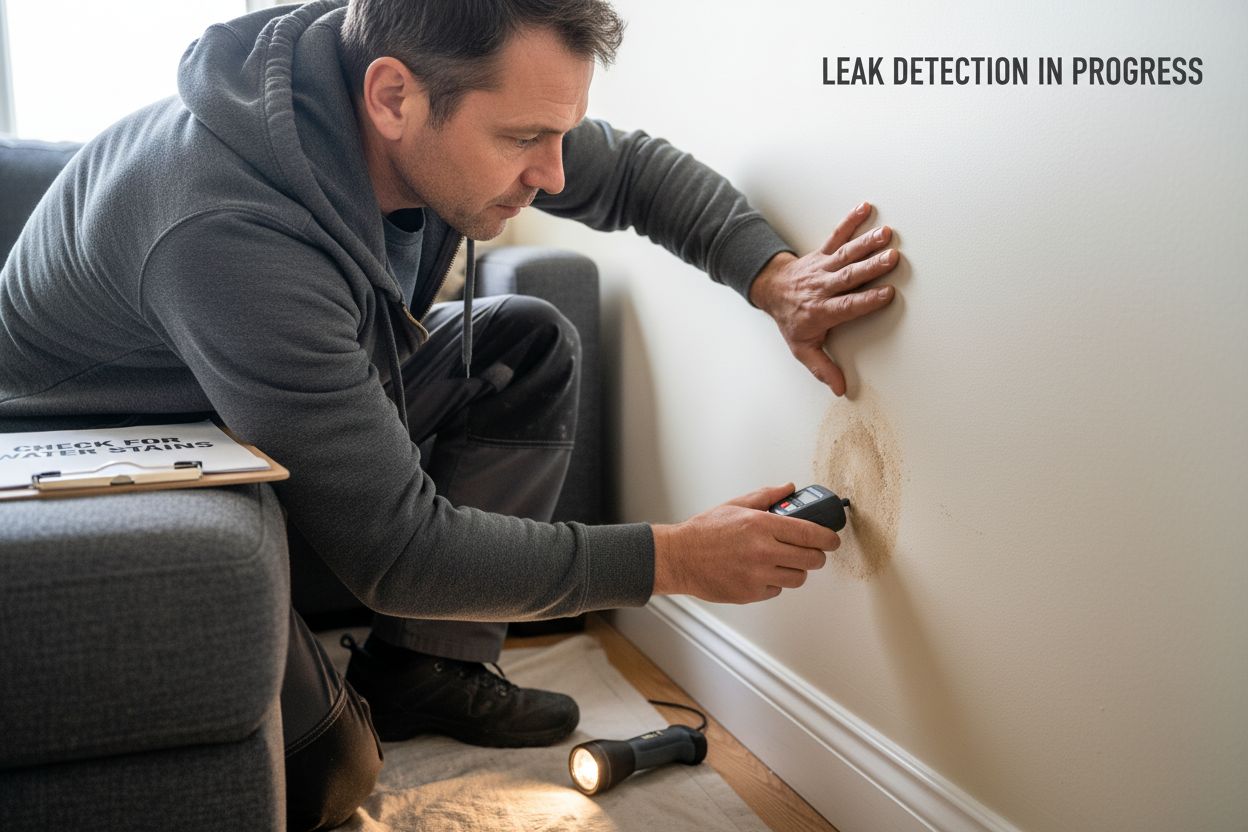 These visual cues are your home’s way of communicating potential structural issues that demand immediate attention.
These visual cues are your home’s way of communicating potential structural issues that demand immediate attention.
Building Research Establishment recommends paying special attention to areas where different building materials meet. Corners, ceiling edges, and wall junctions are particularly vulnerable to water infiltration. Use your moisture metre to measure humidity levels in these regions, as electronic detection can reveal moisture problems invisible to the naked eye.
Inspect less obvious locations like behind furniture, inside cupboards, and along baseboards. Move furniture away from walls and check for subtle signs of dampness or discoloration. Soft or bubbling paintwork, warped wooden surfaces, and musty odours are strong indicators of potential water damage. These signs often suggest long-term moisture issues that might have originated from hidden pipe leaks or structural infiltration.
During your investigation, document everything meticulously. Create a detailed map of your findings, marking areas of concern with precise locations and descriptions. This documentation serves two crucial purposes: tracking potential problem areas and providing valuable information if professional intervention becomes necessary.
Remember that some water damage might not be immediately apparent. Use your thermal camera to identify temperature variations that could indicate moisture presence. Cold spots or unusual thermal patterns might reveal hidden leaks behind walls or under flooring. Trust your senses and be thorough in your examination, understanding that early detection can save significant repair costs and prevent potential structural damage to your home.
Step 4: Conduct a Water Meter Tests
Water metre testing provides one of the most reliable methods for detecting hidden leaks within your home’s plumbing system. This diagnostic approach allows you to identify water loss even when visual inspections reveal no obvious signs of leakage. The process requires patience, precision, and careful observation of your home’s water consumption patterns.
Begin by ensuring absolute water inactivity throughout your property. Turn off all water-consuming appliances, including washing machines, dishwashers, and automatic water systems. Ensure no taps are running and no toilets are refilling. Water Research Centre recommends creating a completely static water environment to obtain accurate leak detection results.
Locate your water metre, typically found near the street or in a basement utility area. Take an initial reading and record the exact time. For the next 30 to 45 minutes, completely abstain from using any water in your home. This means no flushing toilets, running taps, or using any water-related appliances. After the designated time period, return to the water metre and check the reading.
If the metre has moved despite no water usage, you likely have a leak somewhere in your plumbing system.
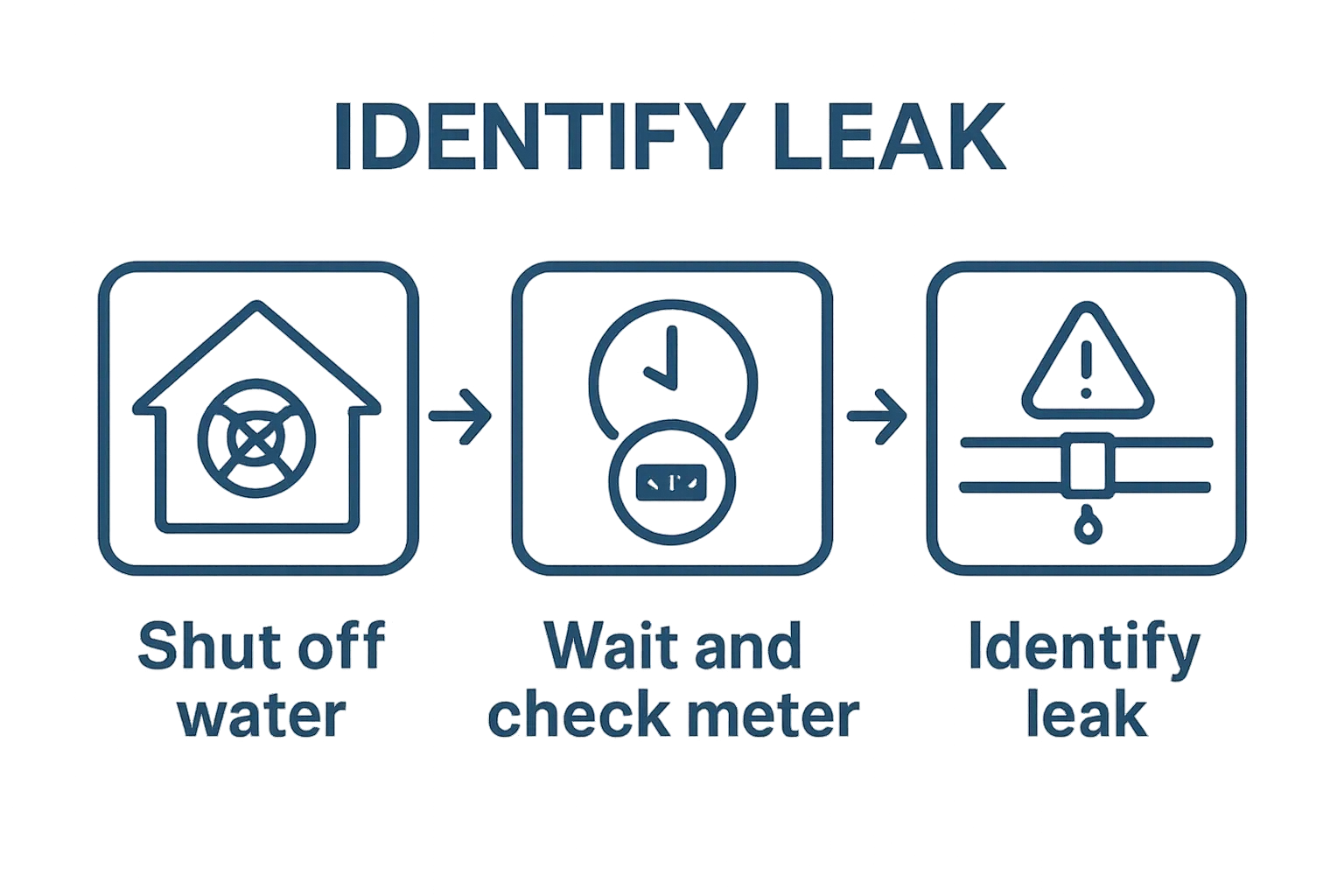 The amount of movement can help indicate the potential severity of the leak.
The amount of movement can help indicate the potential severity of the leak.
Small incremental changes might suggest minor pipe seepage, while significant metre movement could point to more substantial plumbing issues requiring immediate professional attention.
For a more comprehensive test, consider conducting the metre test overnight when household water usage is naturally minimal. Before going to bed, take a precise metre reading. Ensure all water sources are completely shut off and no automatic systems are running. In the morning, check the metre again. Any unexpected movement indicates a potential hidden leak that could be silently causing damage to your property.
Remember that some leaks are intermittent and might not show consistent water metre movement. If you suspect a leak but the metre test seems inconclusive, consider repeating the test multiple times or consulting a professional plumber who can perform more advanced diagnostic procedures. Your diligence in conducting these tests can save significant repair costs and prevent potential long-term structural damage to your home.
Step 5: Use Leak Detection Equipment if Necessary
When visual inspections and water metre tests prove inconclusive, advanced leak detection equipment becomes your next critical investigative tool. Professional-grade technology can uncover hidden leaks that remain invisible to the naked eye, providing precise diagnostic information about your home’s plumbing infrastructure.
Thermal imaging cameras represent one of the most powerful leak detection technologies available to homeowners. These devices detect temperature variations that often indicate moisture presence behind walls, under floors, or within ceiling spaces. Building Research Establishment recommends using thermal cameras as a non-invasive method for identifying potential water infiltration zones.
Accoustic listening devices offer another sophisticated approach to leak detection. These specialised tools amplify the subtle sounds of water movement, allowing you to pinpoint exact leak locations within walls or underground pipes. Professional plumbers frequently use these devices to identify hairline fractures or minor pipe damage that traditional inspection methods might miss.
Moisture metres provide quantitative data about water content in various building materials. By measuring humidity levels in walls, floors, and other structural elements, these devices can reveal hidden moisture accumulations that suggest potential leak sources. Pay special attention to readings near pipe runs, around bathroom fixtures, and in areas with previous water damage history.
When using advanced detection equipment, systematic methodology is crucial. Create a comprehensive grid of your inspection area, moving the device systematically to ensure complete coverage. Document your findings meticulously, recording temperature variations, moisture readings, and any unusual signals detected by your equipment.
Remember that while these tools are powerful, they are not infallible. Complex leak scenarios might require professional intervention. If your own investigations using leak detection equipment remain uncertain or reveal potential significant issues, consulting a professional plumber becomes the most responsible course of action. These experts possess advanced diagnostic tools and the expertise to interpret complex leak indicators accurately, potentially saving you from extensive and costly water damage repairs.
Step 6: Verify and Document Findings
After conducting comprehensive leak detection investigations, the final critical step involves rigorously verifying and documenting your findings. This methodical approach ensures you have a clear understanding of potential issues and provides a solid foundation for future repair or professional intervention strategies.
Create a comprehensive leak investigation report that includes detailed information about every discovered anomaly. Royal Institution of Chartered Surveyors recommends maintaining meticulous records that capture the precise location, extent, and potential implications of each identified leak or moisture issue.
Photograph every suspicious area from multiple angles, ensuring clear, well-lit images that highlight water stains, pipe damage, or moisture accumulation. Include ruler or reference objects in your photographs to provide scale and context. Digital images with timestamp metadata offer valuable documentation that can help track the progression of potential water damage over time.
Prepare a detailed sketch or diagram of your property, marking all locations where leaks or potential moisture issues were discovered. Use different colour codes or symbols to distinguish between minor condensation problems and more significant structural water infiltration. Include precise measurements and notes about the condition of surrounding materials, which can help professional plumbers understand the full scope of potential issues.
Compile a chronological timeline of your leak detection process, noting the specific methods used, equipment employed, and results obtained during each stage of investigation. This systematic documentation serves multiple purposes: it helps you track the evolution of potential problems, provides valuable information for insurance claims, and offers critical insights for future repair strategies.
Finally, assess the severity of your findings and determine the appropriate next steps. Minor condensation issues might require simple preventative measures, while significant structural moisture problems demand immediate professional intervention. Your comprehensive documentation will prove invaluable whether you decide to address repairs independently or consult a professional plumbing specialist.
Below is an overview table summarising the key steps in the leak detection process, with guidance on difficulty and typical time required for each stage.
| Step | Difficulty | Typical Time Required | Key Outcome |
|---|---|---|---|
| Prepare tools and environment | Easy | 10-20 minutes | Safe, clear workspace ready |
| Inspect visible pipes and fixtures | Moderate | 20-40 minutes | Identify visible signs of leaks |
| Check for water stains and dampness | Moderate | 15-30 minutes | Locate hidden moisture/damage areas |
| Conduct a water metre test | Moderate | 30-45 minutes (plus wait) | Detect hidden leaks via meter change |
| Use leak detection equipment if needed | Advanced | 30+ minutes | Pinpoint hard-to-find leaks |
| Verify and document findings | Easy | 15-25 minutes | Complete records for future action |
Need Reliable Leak Detection or Repair? Trust Local Experts for Complete Peace of Mind
After navigating each step of leak detection, you might feel overwhelmed by the hidden risks that water leaks pose to your home. Unnoticed stains, damp patches, or unexplained water metre changes can cause sleepless nights and costly surprises. If you are concerned about your safety or unsure about using tools like moisture metres and thermal cameras, putting off action could mean missing the early signs of larger issues.

Do not leave your comfort and property at risk. Reach out to the trusted professionals at Thermatek Heating & Plumbing for expert help with leak investigations, emergency repairs, or preventative maintenance. Our Gas Safe Registered engineers combine advanced technology with years of experience, ensuring any leak or plumbing challenge is solved efficiently and safely. Book your inspection or request a free quote today at our main site. Let us help you protect your home and restore your peace of mind before small leaks become serious problems.
Frequently Asked Questions
How can I tell if I have a leak in my home?
To determine if you have a leak, inspect visible pipes and fixtures for signs of moisture or water damage, check for water stains on walls and ceilings, and conduct a water meter test to monitor for unexplained water usage.
What tools do I need for leak detection?
Essential tools for leak detection include a moisture metre, infrared thermal camera, pressure testing equipment, adjustable wrench, flashlight, protective gloves, safety goggles, and a notebook for documenting findings.
What are the signs of a hidden leak?
Signs of a hidden leak include water stains or discoloration on walls or ceilings, damp or warped materials, musty odours, and unexpected increases in your water bill.
When should I call a professional for leak detection?
If your leak detection efforts do not lead to conclusive results, or if you suspect significant plumbing issues, it is advisable to call a professional plumber. They have advanced tools and expertise to accurately diagnose and address complex leak problems.
Recommended
- News - Thermatek Heating
- Landlord Gas Safety Certificates In Edinburgh - Thermatek Heating
- Boiler Installation Quote - Thermatek Heating
- Annual Boiler Servicing In Edinburgh - Thermatek Heating
What is Power Flushing? Understanding Its Importance
Most people think of radiators and boilers as simple background fixtures quietly keeping homes warm. Yet hidden beneath the surface, sludge buildup can quietly drag your energy efficiency down by as much as 30 percent over time. What few realise is that a simple power flushing treatment could rescue your entire system from early failure and deliver savings you never knew were slipping away.
Table of Contents
- Defining Power Flushing: A Comprehensive Overview
- The Importance Of Power Flushing For Heating Systems
- How Power Flushing Works: The Science Behind It
- Key Concepts In Power Flushing: Understanding The Process
- The Benefits Of Power Flushing For Homeowners And Landlords
Quick Summary
| Takeaway | Explanation |
|---|---|
| Regular power flushing enhances heating efficiency. | Power flushing removes sludge and debris, improving system performance by up to 15%. |
| Investing in power flushing can save money. | It reduces energy costs and prevents costly repairs, extending system lifespan significantly. |
| Professional assessment is crucial before power flushing. | A thorough diagnostic evaluation ensures all system components are effectively treated. |
| Power flushing prevents future heating issues. | By addressing internal contamination, it minimises risks of system breakdowns and cold spots. |
| Landlords benefit from regular power flushing. | This maintenance meets legal safety standards while ensuring tenant comfort and system reliability. |
Defining Power Flushing: A Comprehensive Overview
Power flushing represents a critical maintenance procedure designed to clean and restore the efficiency of central heating systems by removing accumulated debris, sludge, and contaminants from pipework and radiators. Unlike standard cleaning methods, power flushing uses high-pressure water and specialised chemical treatments to comprehensively clear out blockages that can significantly reduce heating performance.
The Science Behind Power Flushing
At its core, power flushing addresses the gradual build-up of magnetite (iron oxide) and other particulate matter within heating systems. These contaminants accumulate over time, forming a thick, muddy substance known as central heating sludge. According to British Heating and Plumbing Magazine, this sludge can reduce heating system efficiency by up to 15% and potentially cause long-term damage to boilers and radiators.
The power flushing process involves several key scientific principles:
- Utilising high-velocity water flow to dislodge and remove stubborn debris
- Introducing specialised cleaning chemicals that break down mineral deposits
- Applying reverse-flow techniques to ensure comprehensive system cleaning
- Neutralising chemical reactions that contribute to corrosion and scale build-up
Understanding System Impact and Benefits
Power flushing goes beyond simple maintenance, offering substantial benefits for residential and commercial heating systems. Energy Efficiency Institute research indicates that regular power flushing can:
- Improve overall heating system efficiency
- Extend the lifespan of boilers and radiators
- Reduce energy consumption and associated utility costs
- Prevent potential expensive repair or replacement scenarios
By systematically removing internal system contamination, power flushing ensures that heating networks operate at peak performance, delivering consistent warmth while minimising potential long-term mechanical complications.
The Importance of Power Flushing for Heating Systems
Heating system efficiency and longevity depend significantly on regular maintenance, with power flushing emerging as a critical intervention strategy. By systematically addressing internal system contamination, power flushing prevents potential catastrophic failures and ensures optimal performance across residential and commercial heating networks. Central Heating Power Flushing In Edinburgh - Thermatek Heating emphasises the crucial role of this maintenance procedure in preserving heating system functionality.
Economic and Performance Implications
The economic rationale for power flushing extends far beyond simple maintenance. According to Energy Saving Trust, poorly maintained heating systems can lose up to 30% of their operational efficiency, resulting in substantially higher energy consumption and increased utility expenses. This efficiency degradation stems from several key factors:
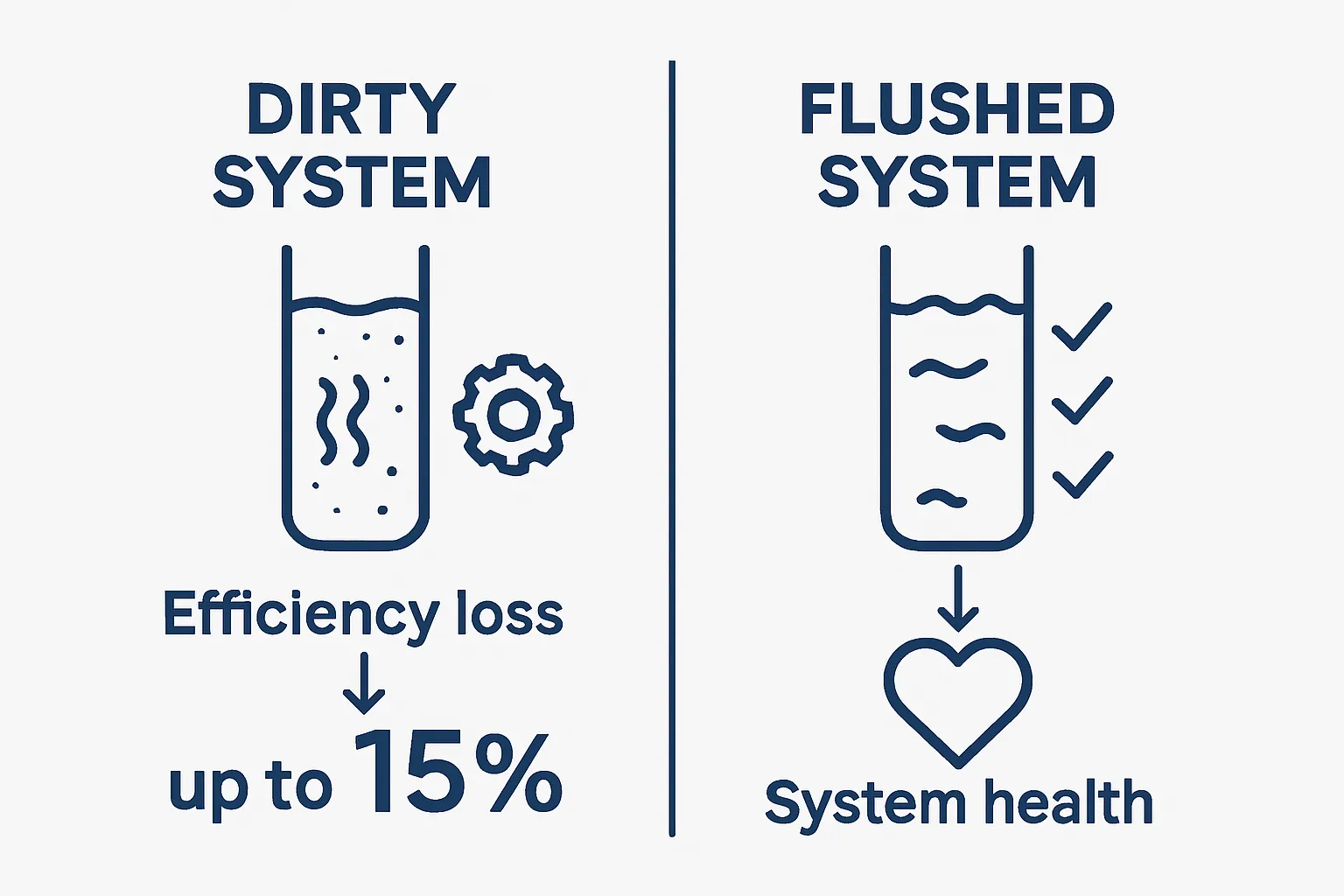
- Accumulated debris restricting water circulation
- Reduced heat transfer capabilities
- Increased strain on boiler components
- Potential premature system failure
Long-Term System Health and Reliability
Power flushing represents a proactive approach to heating system management, addressing potential issues before they escalate into expensive repairs. Professional engineers recommend this procedure as a preventative measure to:
- Eliminate corrosive materials that cause system deterioration
- Restore optimal heat distribution across radiators
- Prevent cold spots and uneven heating performance
- Minimise the risk of unexpected system breakdowns
By investing in regular power flushing, homeowners can significantly extend their heating system’s operational lifespan, reduce potential repair costs, and maintain consistent thermal comfort throughout their property.
How Power Flushing Works: The Science Behind It
Power flushing represents a sophisticated heating system restoration technique that combines advanced fluid dynamics, chemical treatments, and precision engineering to comprehensively clean internal pipework and radiator networks. Annual Boiler Servicing In Edinburgh - Thermatek Heating recognises this procedure as a critical maintenance intervention that goes far beyond traditional cleaning methods.
Mechanical Principles of Cleaning
The fundamental mechanism of power flushing relies on high-velocity water circulation and targeted chemical treatments. According to Heating Engineering Research Institute, the process utilises specialized equipment that generates powerful water flows capable of dislodging and removing accumulated system contaminants. These mechanical principles involve:
- Generating water pressures between 3-4 bars
- Creating turbulent flow patterns to maximise debris removal
- Implementing multi-directional water circulation
- Using precise flow control mechanisms
Chemical Treatment and Contamination Removal
Chemical interventions play a crucial role in the power flushing process, transforming how internal system contaminants are neutralised and extracted. The chemical treatment stage involves:
- Introducing pH-balanced cleaning agents
- Breaking down magnetite and mineral deposits
- Neutralising corrosive compounds
- Preventing future scale and rust formation
These chemical treatments work synergistically with mechanical flushing techniques, ensuring a comprehensive system restoration that addresses both physical debris and potential chemical degradation mechanisms. By combining advanced fluid dynamics with targeted chemical interventions, power flushing provides a holistic approach to heating system maintenance and performance optimization.
To help clarify the distinctions and contributions of both mechanical and chemical processes within power flushing, the following table summarises their core characteristics and roles.
| Aspect | Mechanical Principles | Chemical Treatments |
|---|---|---|
| Method | High-velocity water circulation | Introduction of specialised cleaning agents |
| Purpose | Dislodge and remove physical debris | Break down and neutralise chemical contaminants |
| Process Features | Turbulent, multi-directional flow | pH-balanced, targeted chemical action |
| Main Targets | Sludge, blockages, particulate matter | Magnetite, mineral deposits, corrosives |
| Benefits | Clears pipework and radiators | Prevents corrosion, scale, and future build-up |
| Role in System Restoration | Physical cleansing and improvement | Chemical stabilisation and protection |
Key Concepts in Power Flushing: Understanding the Process
Power flushing represents a sophisticated heating system maintenance technique that demands precise understanding of its core principles and operational mechanisms. Professional heating engineers emphasise the critical nature of comprehensive system assessment and targeted intervention strategies. News - Thermatek Heating highlights the importance of advanced technical knowledge in executing effective power flushing procedures.
System Contamination and Diagnostic Assessment
Before conducting a power flush, heating professionals must perform a comprehensive diagnostic evaluation of the system’s condition. UK Parliamentary Research indicates that effective power flushing requires a meticulous assessment to ensure all circuits and components receive thorough treatment. Key diagnostic considerations include:
- Identifying magnetite and sludge accumulation patterns
- Measuring system water quality and pH levels
- Evaluating radiator and pipework temperature consistency
- Assessing potential corrosion indicators
Chemical and Mechanical Intervention Strategies
Power flushing integrates sophisticated chemical treatments with precision mechanical techniques to restore heating system performance. The intervention process focuses on:
- Introducing targeted cleaning agents
- Generating high-velocity water circulation
- Implementing multi-directional flushing techniques
- Neutralising internal system contaminants
By systematically addressing both physical debris and chemical degradation mechanisms, power flushing provides a comprehensive approach to heating system restoration. This method ensures optimal thermal efficiency, reduces potential long-term damage, and extends the operational lifespan of critical heating infrastructure.
The Benefits of Power Flushing for Homeowners and Landlords
Power flushing offers substantial advantages for property owners, providing a proactive maintenance strategy that safeguards heating infrastructure and optimises system performance. Landlord Gas Safety Certificates In Edinburgh - Thermatek Heating recognises the critical role of comprehensive heating system maintenance in property management.
Financial and Performance Advantages
For homeowners and landlords, power flushing represents a strategic investment with measurable economic benefits. According to Which? Trusted Traders, regular system maintenance can reduce energy consumption and prevent costly repairs. Key financial benefits include:
- Reducing annual heating costs by up to 15%
- Preventing expensive boiler replacements
- Extending heating system operational lifespan
- Minimising unexpected repair expenses
Property Management and Compliance Considerations
Landlords face unique challenges in maintaining rental property heating systems, with legal and safety obligations playing a crucial role. Power flushing contributes significantly to meeting these requirements by:
- Ensuring consistent heating performance
- Maintaining system reliability for tenant comfort
- Demonstrating proactive property maintenance
- Supporting compliance with rental property standards
By implementing regular power flushing, property owners protect their investment, reduce long-term maintenance costs, and provide safe, efficient heating environments for residents. This approach transforms heating system maintenance from a reactive task to a strategic property management tool.
This table organises the primary financial and operational advantages of power flushing for both homeowners and landlords, emphasising how it supports efficient, cost-effective, and compliant property management.
| Benefit | Description |
|---|---|
| Annual Heating Cost Reduction | Reduces ongoing energy expenses by up to 15% |
| Boiler Replacement Prevention | Minimises risk of expensive boiler breakdowns and replacements |
| Extended System Lifespan | Enhances the durability of boilers and radiators |
| Unexpected Repair Minimisation | Lowers the likelihood and cost of unplanned repair work |
| Tenant Comfort and Compliance | Ensures heating reliability and supports compliance in rental properties |
| Property Value Preservation | Helps maintain system performance for long-term asset protection |
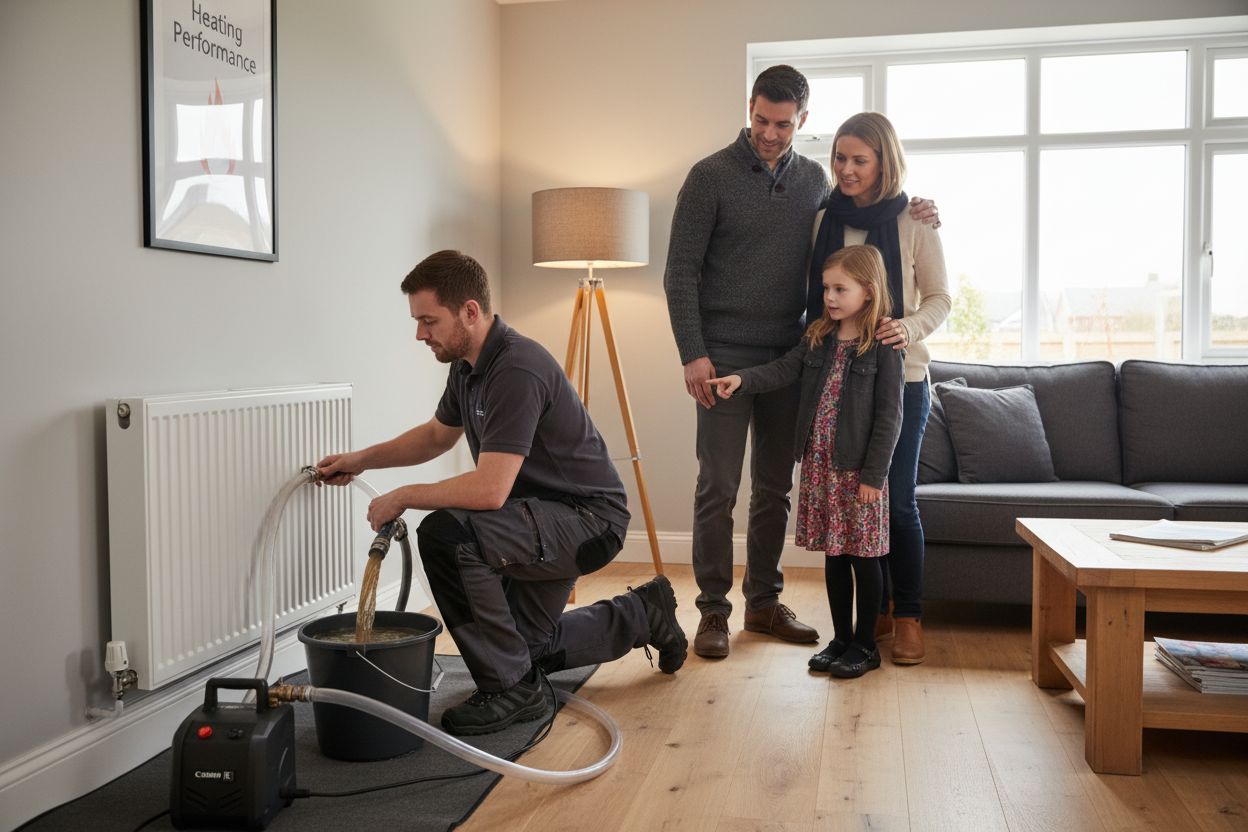
Restore Your Heating Efficiency with Professional Power Flushing
Is your central heating system struggling with cold spots, noisy radiators or high energy bills? As highlighted in our recent article, the build-up of sludge, magnetite and debris can silently undermine both performance and reliability. Even a small amount of internal contamination may cause your system to work much harder, risking costly breakdowns and reducing comfort in your home. With so much at stake, expert intervention is not just helpful but essential for lasting peace of mind.

Take control and protect your property by choosing a Gas Safe Registered local expert. The team at Thermatek Heating specialises in thorough power flushing solutions designed for Edinburgh and Midlothian homes. Every service uses advanced techniques that target the exact issues discussed in the article, ensuring reliable performance and energy savings. Book your inspection today and enjoy a warmer and more efficient home year-round. Simply request your free quote or consultation now. Act promptly to avoid unexpected heating disruption and future repair bills.
Frequently Asked Questions
What is power flushing and how does it work?
Power flushing is a maintenance procedure for central heating systems that uses high-pressure water and specialised chemicals to remove accumulated debris, sludge, and contaminants from pipework and radiators. It employs high-velocity water flow and chemical treatments to dislodge and eliminate blockages, restoring system efficiency.
Why is power flushing important for heating systems?
Power flushing is essential as it improves heating system efficiency, extends the lifespan of boilers and radiators, reduces energy consumption, and prevents costly repairs. Regular power flushing helps eliminate sludge build-up that can degrade system performance over time.
How often should power flushing be performed?
It is generally recommended to consider power flushing every 5 to 7 years, or sooner if you notice inefficiencies such as cold spots in radiators, unusual noises from the boiler, or increased energy bills. Regular inspection and maintenance are key in determining the right frequency for your system.
What are the benefits of power flushing for homeowners?
Power flushing offers significant benefits for homeowners, including reduced annual heating costs, prevention of expensive boiler replacements, extended operational lifespan of the heating system, and minimised unexpected repair expenses. It ensures a comfortable and efficient home heating environment.
Recommended
- Central Heating Power Flushing In Edinburgh - Thermatek Heating
- News - Thermatek Heating
- Annual Boiler Servicing In Edinburgh - Thermatek Heating
- Plumbing Services In Edinburgh - Thermatek Heating
Understanding Outdoor Heating Options for Your Space
Outdoor heating options are transforming how people use patios and gardens, turning chilly evenings into cosy moments right outside your door. Some home experts even state that outdoor spaces with heating can boost property value by up to 20 percent. Most people think outdoor heaters are an expensive luxury for restaurants or lavish events, but the real surprise is that there are practical and affordable solutions for nearly every home or business, and their energy use is lower than you might expect.
Table of Contents
- What Are Outdoor Heating Options And Their Purpose?
- Why Outdoor Heating Matters For Homes And Businesses
- How Different Outdoor Heating Systems Work
- Key Concepts In Choosing Outdoor Heating Solutions
Quick Summary
| Takeaway | Explanation |
|---|---|
| Invest in outdoor heating systems for all-season comfort | These solutions allow you to utilise outdoor spaces comfortably even in colder months, enhancing your lifestyle and property usability. |
| Consider energy efficiency in heating technology | Opt for systems that provide warm, direct heating with lower energy consumption, ensuring both comfort and sustainability. |
| Enhance property value with heated outdoor spaces | Effective outdoor heating can increase your property’s market value by up to 20%, making it a valuable investment for homeowners. |
| Assess your specific space and needs before choosing | Different heating technologies are better suited for different environments; consider your space, climate, and budget when deciding. |
| Balance performance with environmental impact | Think about initial and long-term costs, as well as sustainability, to select a heating solution that matches your environmental goals. |
What Are Outdoor Heating Options and Their Purpose?
Outdoor heating options represent versatile solutions designed to extend comfortable living and entertainment spaces beyond traditional indoor boundaries. These heating systems enable individuals to enjoy exterior environments during cooler temperatures, transforming patios, decks, gardens, and outdoor social areas into year-round functional spaces.
Understanding the Core Purpose
The primary purpose of outdoor heating options is to create warmth and comfort in external environments. By generating radiant heat, these systems allow people to remain comfortable while enjoying fresh air and open spaces. Research from the National Renewable Energy Laboratory indicates that modern outdoor heating technologies can provide efficient warmth with minimal energy consumption.
Outdoor heating solutions serve multiple practical objectives:
- Extending usable living spaces during colder months
- Creating comfortable social gathering environments
- Enhancing property value and aesthetic appeal
- Providing supplementary heating for outdoor work or leisure areas
Types of Outdoor Heating Technologies
Outdoor heating options encompass a diverse range of technologies designed to suit different spaces and requirements. These include infrared heaters, propane patio heaters, electric radiant heaters, and wood-burning fire pits.
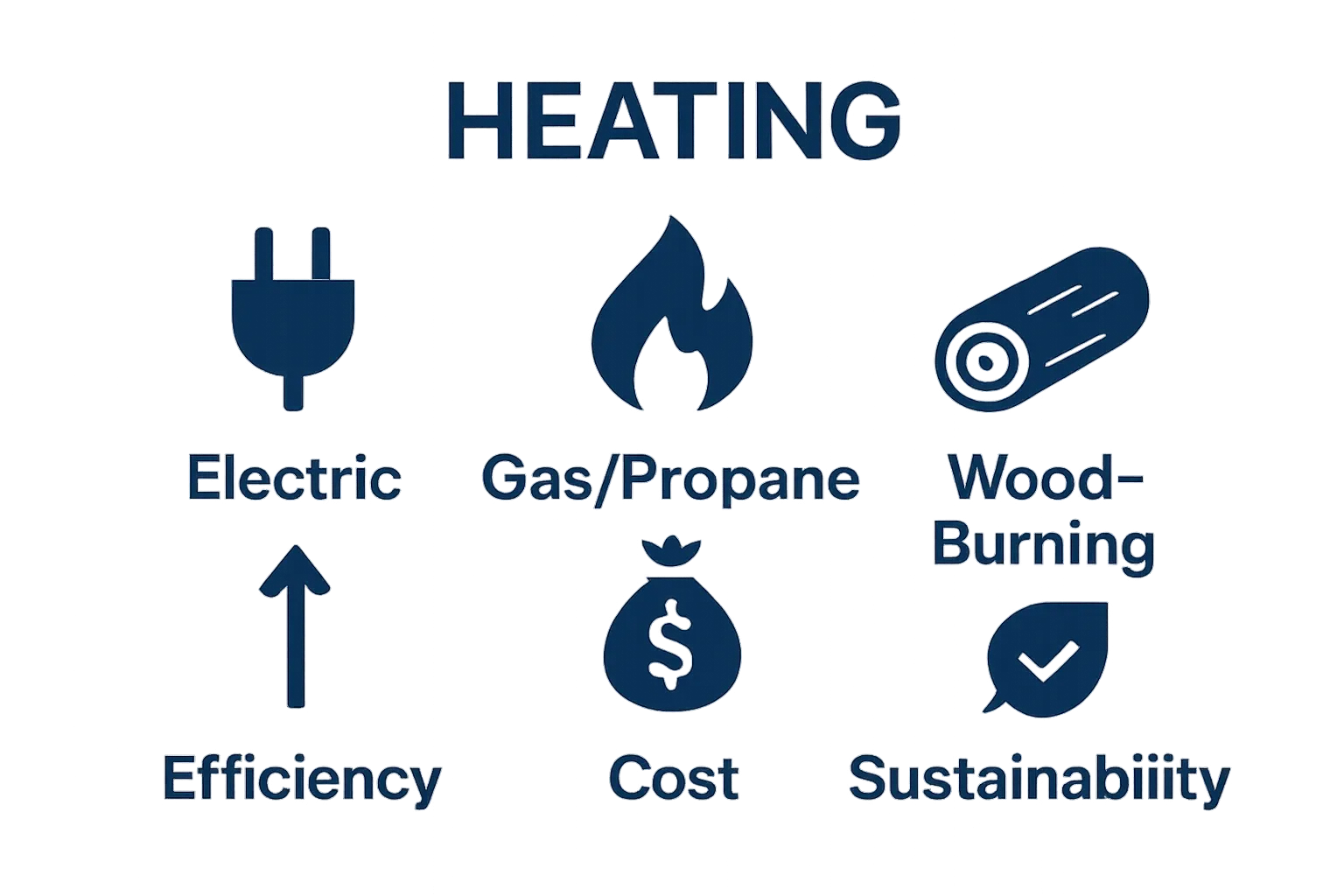 Each technology offers unique advantages in terms of heat distribution, energy efficiency, and installation complexity.
Each technology offers unique advantages in terms of heat distribution, energy efficiency, and installation complexity.
The selection of an appropriate outdoor heating option depends on several critical factors such as available space, local climate conditions, budget constraints, and specific usage requirements.
Below is a comparison of the key types of outdoor heating technologies, outlining their primary characteristics to help you evaluate which option aligns with your needs.
| Heating Technology | Energy Source | Key Advantages | Considerations |
|---|---|---|---|
| Infrared Heaters | Electricity | Direct heat, energy-efficient | Requires power source, limited range |
| Propane Patio Heaters | Propane Gas | Portable, strong heat output | Ongoing fuel purchase, CO2 emissions |
| Electric Radiant Heaters | Electricity | Clean operation, rapid warm-up | Electrical installation needed |
| Wood-Burning Fire Pits | Wood | Traditional ambience, cost-effective | Smoke production, fuel storage |
By integrating suitable outdoor heating solutions, individuals can transform exterior spaces into comfortable, functional areas that seamlessly blend comfort, practicality, and aesthetic appeal throughout different seasonal conditions.
Why Outdoor Heating Matters for Homes and Businesses
Outdoor heating solutions have transitioned from luxury amenities to essential infrastructure for residential and commercial spaces. These systems provide strategic advantages that extend far beyond simple temperature management, offering significant economic, social, and functional benefits for property owners.
Economic and Property Value Considerations
Investing in outdoor heating represents a smart financial strategy for both homeowners and businesses. According to property valuation experts at the Royal Institution of Chartered Surveyors, well-designed outdoor spaces with heating capabilities can increase property market value by up to 20%. Functional exterior spaces become attractive selling points, demonstrating how outdoor heating transforms underutilised areas into valuable living and working environments.
Key economic benefits include:
- Extending usable outdoor space throughout different seasons
- Reducing indoor heating costs by creating comfortable external areas
- Enhancing property marketability and potential resale value
- Providing cost-effective supplementary heating solutions
Social and Functional Advantages
Beyond financial considerations, outdoor heating plays a crucial role in social interaction and workspace flexibility. Restaurants, cafes, and hospitality businesses leverage outdoor heating to maintain customer comfort and extend operational capacities during cooler periods. Residential properties similarly benefit by creating welcoming outdoor entertainment zones that encourage social gatherings.

Research from the International Energy Agency highlights that modern outdoor heating technologies are becoming increasingly energy-efficient, allowing businesses and homeowners to balance comfort with sustainability. These innovations enable people to utilise exterior spaces more effectively, transforming patios, gardens, and commercial terraces into year-round functional environments.
Check out our latest news for more insights into innovative heating solutions that can transform your outdoor living and working spaces.
How Different Outdoor Heating Systems Work
Modern outdoor heating systems employ various technological approaches to generate warmth in external environments, each with unique mechanisms and performance characteristics. Understanding these technologies helps property owners select the most suitable solution for their specific requirements.
Radiant Heating Technologies
Radiant heating systems operate by directly warming objects and people rather than heating surrounding air. Research from the American Society of Heating, Refrigerating and Air-Conditioning Engineers demonstrates that these technologies offer superior energy efficiency compared to traditional heating methods.
Key characteristics of radiant heating include:
- Direct heat transfer through infrared radiation
- Minimal heat loss through air circulation
- Rapid warm-up times
- Consistent temperature distribution
- Reduced energy consumption
Fuel and Power Source Variations
Outdoor heating systems utilise diverse energy sources, each presenting distinct operational principles. Electric radiant heaters convert electrical energy into heat through resistive elements, while gas-powered systems like propane heaters combust fuel to generate thermal energy. Wood-burning options provide a more traditional approach, leveraging combustion of organic materials.
Experts from the Energy Saving Trust recommend evaluating local energy costs, environmental impact, and installation requirements when selecting an appropriate heating technology. Some systems offer greater flexibility and efficiency than others, depending on specific environmental conditions.
Learn more about advanced heating solutions with our heat pump installation guide to understand cutting-edge thermal management technologies.
The selection of an outdoor heating system ultimately depends on balancing factors such as initial investment, ongoing operational costs, environmental considerations, and specific spatial requirements. By comprehending the underlying mechanics of different heating technologies, property owners can make informed decisions that maximise comfort and energy efficiency.
Key Concepts in Choosing Outdoor Heating Solutions
Selecting the right outdoor heating solution requires a comprehensive understanding of multiple interconnected factors. Property owners must navigate technical specifications, environmental considerations, and practical performance metrics to make informed decisions that align with their specific requirements.
Performance and Efficiency Metrics
Thermal efficiency represents a critical evaluation parameter when assessing outdoor heating technologies. Research from the Carbon Trust indicates that modern heating systems can achieve significant energy savings through advanced design principles and intelligent heat distribution strategies.
Key performance considerations include:
This table organises the main performance and efficiency metrics used to assess outdoor heating systems, providing a reference for comparing different technologies discussed in the article.
| Metric | Explanation |
|---|---|
| Heat Output (kW) | Measures the amount of warmth produced, usually in kilowatts |
| Energy Consumption Rate | Indicates how much energy the system uses during operation |
| Heat Distribution Radius | Specifies the effective area covered by the heater |
| Operational Temperature Range | Range of temperatures within which the heater performs effectively |
| Thermal Conversion Efficiency | Percentage of input energy converted to usable heat |
- Heat output measurement in kilowatts (kW)
- Energy consumption rates
- Heat distribution radius
- Operational temperature range
- Thermal conversion efficiency
Environmental and Economic Factors
Beyond immediate thermal performance, outdoor heating solutions must be evaluated through broader environmental and economic lenses. Sustainable heating technologies increasingly prioritise reduced carbon emissions and lower operational costs. Gas, electric, and renewable energy systems present distinct advantages and potential limitations.
Experts from the UK Green Building Council recommend comprehensive assessments that consider:
- Initial equipment investment
- Long-term operational expenses
- Carbon footprint
- Potential renewable energy integration
- Local climate adaptability
Explore our heat pump installation guide to understand advanced sustainable heating technologies that balance performance and environmental responsibility.
Ultimately, selecting outdoor heating solutions requires balancing technical specifications, economic constraints, and individual spatial requirements. By adopting a holistic approach that considers multiple evaluation criteria, property owners can identify heating technologies that provide optimal comfort, efficiency, and value.
Upgrade Your Outdoor Space with Expert Heating Solutions
Are you seeking to make your patio or garden comfortable all year round, but feeling uncertain about which outdoor heating option best suits your lifestyle and space? If you want to keep your exterior areas warm while prioritising energy efficiency, safety, and long-term savings, then you need professional support tailored to your specific needs. At Thermatek, our Gas Safe Registered engineers draw on extensive expertise to help homeowners, landlords, and property managers across Edinburgh and Midlothian select, install, and maintain the right heating solution for every season. We understand the importance of technical performance, energy-saving features, and sustainable choices as outlined in our heat pump installation guide, and we’re ready to deliver reliable service you can trust.

Ready to transform your outdoor space into a comfortable and inviting extension of your home? Secure an efficient and safe heating system from local experts today. Visit Thermatek Heating now to request your free quote and discover our comprehensive range of heating and renewable solutions. Act now and enjoy warmth and peace of mind whenever you step outside.
Frequently Asked Questions
What are the main outdoor heating options available?
Outdoor heating options include infrared heaters, propane patio heaters, electric radiant heaters, and wood-burning fire pits. Each type has unique advantages concerning heat distribution, energy efficiency, and installation requirements.
How do radiant heating systems work in outdoor spaces?
Radiant heating systems work by directly warming objects and people rather than just heating the surrounding air. This direct heat transfer through infrared radiation results in minimal heat loss, rapid warm-up times, and energy efficiency.
What factors should I consider when selecting an outdoor heating solution?
Key factors include thermal efficiency, energy consumption rates, heat distribution radius, initial investment, long-term operational costs, local climate conditions, and potential renewable energy integration.
Can outdoor heating systems help reduce my indoor heating costs?
Yes, by creating comfortable external areas, outdoor heating systems can extend the usable outdoor space and reduce reliance on indoor heating during get-togethers, potentially lowering overall heating expenses.
Recommended
- News - Thermatek Heating
- Air Source Heat Pump Installation In Edinburgh - Thermatek Heating
- Solar Thermal Installers In Edinburgh - Thermatek Heating
- Local Heating Installer Kicks Off His New Business With £500 Birthday Present - Thermatek Heating
Understanding the Difference Between Combi and System Boilers
Choosing the right boiler can make a huge difference at home, especially when you learn that a well-chosen boiler can cut heating bills by up to 30 percent every year. Most people think all you need to consider is heating power or brand. What actually matters even more is whether you pick a combi or system boiler, because this choice quietly shapes both your comfort and your budget far more than you might expect.
Table of Contents
- What Are Combi And System Boilers?
- Why Choosing The Right Boiler Matters For Your Home
- How Combi Boilers Function And Their Benefits
- How System Boilers Work And Their Advantages
- Comparing Combi And System Boilers: Key Differences
Quick Summary
| Takeaway | Explanation |
|---|---|
| Combi boilers are space-saving solutions | Ideal for smaller homes, combi boilers provide heating and hot water from a single compact unit without a separate storage tank. |
| System boilers suit larger households | They provide simultaneous hot water supply from a separate cylinder, making them perfect for homes with multiple bathrooms. |
| Choosing the right boiler impacts costs | The right boiler can reduce energy bills significantly, with efficient systems cutting heating costs by up to 30%. |
| Energy efficiency varies between types | Modern combi and system boilers can achieve over 90% efficiency, contrasting with older models that may operate at lower efficiency levels. |
| Installation complexity differs | Combi boilers are easier to install due to their integrated design, while system boilers require more space and a more complex setup. |
What are Combi and System Boilers?
Heating systems play a crucial role in maintaining comfort and efficiency in homes across the United Kingdom. Understanding the difference between combi and system boilers is essential for homeowners looking to make informed decisions about their heating infrastructure. System and combination boilers represent two distinct approaches to home heating, each with unique characteristics and benefits.
Combi Boilers: Compact and On-Demand
A combi (combination) boiler is a compact, all-in-one heating solution that provides both central heating and hot water directly from the main unit. Unlike traditional systems, combi boilers do not require a separate hot water cylinder or storage tank. When you turn on a hot water tap, the boiler instantly heats water as it passes through, delivering hot water on demand.
Key characteristics of combi boilers include:
- Compact size ideal for smaller properties
- Instant hot water without waiting
- No separate water storage required
- Generally more energy efficient
System Boilers: Storage and Flexibility
System boilers differ from combis by incorporating a separate hot water cylinder for storing heated water. This design allows for multiple hot water outlets to be used simultaneously, making them suitable for larger households with higher hot water demands. The boiler heats water which is then stored in an insulated cylinder, ready for use when needed.
Crucial considerations for system boilers include:
- Better performance in homes with multiple bathrooms
- Consistent hot water supply
- Compatibility with solar thermal systems
- Slightly more complex installation
Learn more about our boiler replacement services to understand which option might best suit your home’s specific heating requirements.
Why Choosing the Right Boiler Matters for Your Home
Selecting an appropriate heating system is far more than a simple purchasing decision. Energy experts emphasize that the right boiler can significantly impact your home’s comfort, energy efficiency, and long-term financial sustainability.
Financial Implications of Boiler Selection
The type of boiler you choose directly influences your household energy expenses. Inefficient boilers can waste substantial energy, leading to higher utility bills and unnecessary carbon emissions. A well-selected boiler can reduce annual heating costs by up to 30%, making the initial investment in the correct system a smart financial strategy.
Key financial considerations include:
- Upfront installation costs
- Ongoing energy consumption
- Potential maintenance expenses
- Long-term efficiency ratings
Energy Efficiency and Environmental Impact
Modern boilers are designed with advanced technologies that prioritize energy conservation. The right boiler not only keeps your home warm but also minimizes environmental footprint. Combi and system boilers have different efficiency profiles, with some models achieving over 90% energy efficiency compared to older systems that might operate at 60-70%.
Crucial performance factors to evaluate:
- Heat output matching your home’s requirements
- Water heating capacity
- Compatibility with existing heating infrastructure
- Potential for future renewable energy integration
Learn more about our annual boiler servicing to ensure your heating system maintains peak performance and efficiency throughout its lifecycle.
How Combi Boilers Function and Their Benefits
Combi boilers represent a sophisticated and efficient heating solution that has transformed residential heating across the United Kingdom. Modern heating technologies have made these compact units increasingly popular among homeowners seeking streamlined and energy-efficient heating systems.
The Working Mechanism of Combi Boilers
At the core of a combi boiler’s functionality is its ability to heat water instantaneously. When a hot water tap is turned on, cold water travels directly from the mains through the boiler’s heat exchanger. The boiler rapidly heats the water to the desired temperature, delivering hot water on demand without the need for a separate storage cylinder.
Key operational characteristics include:
- Direct water heating from mains supply
- Instantaneous hot water production
- Compact single-unit design
- No requirement for additional water storage tanks
Advantages of Choosing a Combi Boiler
The benefits of combi boilers extend far beyond their compact design. These systems offer significant advantages for modern households, particularly those with limited space or seeking maximum energy efficiency. By eliminating the need for a separate hot water cylinder, combi boilers reduce heat loss and minimize installation complexity.
Primary benefits homeowners experience:
- Reduced energy consumption
- Lower installation and maintenance costs
- Consistent hot water supply
- Space-saving design ideal for smaller properties
Explore our solar thermal systems to discover how you can further enhance your home’s energy efficiency alongside your combi boiler installation.
How System Boilers Work and Their Advantages
Heating system technologies have evolved significantly, with system boilers emerging as a robust solution for households requiring consistent and flexible hot water supply. These sophisticated heating units represent a powerful alternative to traditional heating configurations.
Operational Mechanics of System Boilers
System boilers operate through a distinctive process that separates water heating from central heating generation. The primary unit connects directly to a separate hot water cylinder, allowing for simultaneous heating of multiple water outlets. When activated, the boiler heats water which is then stored in an insulated cylinder, maintaining temperature and readiness for immediate use.
Key operational components include:
- Central boiler unit
- Separate hot water cylinder
- Advanced heat exchanger
- Integrated pump system
Comprehensive Advantages for Modern Homes
Unlike combi boilers, system boilers provide exceptional flexibility for households with higher hot water demands. They excel in environments with multiple bathrooms or significant simultaneous water usage. The separate cylinder allows for storing larger quantities of hot water, ensuring consistent supply even during peak usage periods.
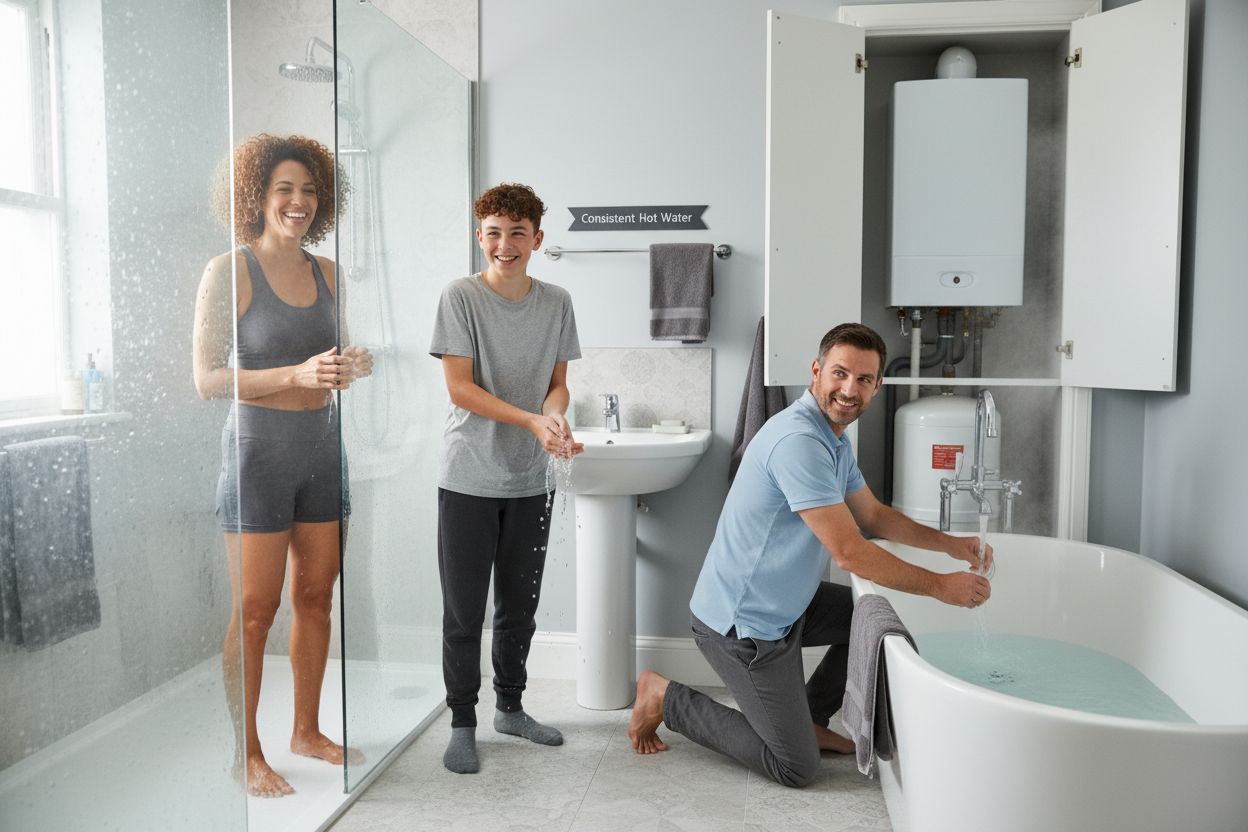
Notable system boiler advantages:
- Support for multiple simultaneous hot water outlets
- Compatible with renewable energy technologies
- Superior performance in larger households
- Enhanced water pressure across different taps
Check out our latest heating news to stay informed about emerging heating technologies and system boiler innovations.
Comparing Combi and System Boilers: Key Differences
Heating system technologies reveal distinct characteristics that make combi and system boilers unique solutions for different household needs. Understanding these fundamental differences helps homeowners make informed decisions about their heating infrastructure.
To help clarify the fundamental differences between combi and system boilers, the following table compares key features, advantages, and suitability for each type.
| Feature / Aspect | Combi Boiler | System Boiler |
|---|---|---|
| Space Requirements | Compact, single unit; ideal for smaller homes | Requires separate cylinder; needs more installation space |
| Hot Water Supply | Instant, on-demand; no storage tank | Stored hot water in separate cylinder; supports multiple outlets |
| Installation Complexity | Easier and quicker to install | More complex due to additional components |
| Suitable Household Size | Smaller homes with fewer bathrooms | Larger homes; multiple bathrooms and higher demand |
| Energy Efficiency | High; minimal heat loss | High; may lose heat from cylinder if poorly insulated |
| Water Pressure | Good with strong mains pressure | Consistent, even with multiple taps running |
| Compatibility with Renewables | Limited (solar preheat possible) | Good; can integrate with solar thermal systems |
Structural and Design Variations
Combi boilers are compact, integrated units that provide heating and hot water directly from a single source. In contrast, system boilers feature a separate hot water cylinder, creating a more complex but versatile heating setup. The primary structural difference lies in their water storage and delivery mechanisms.
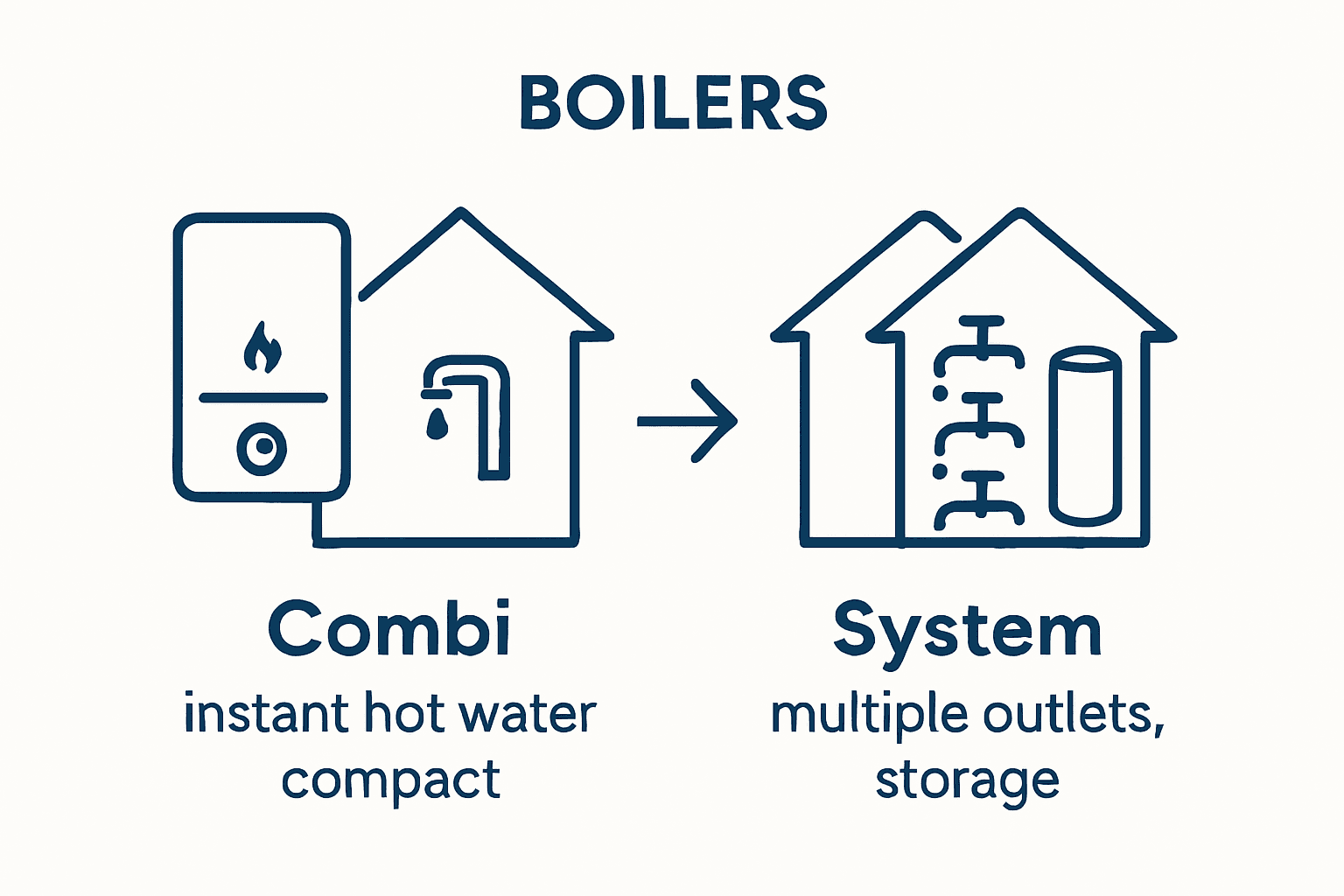
Key structural distinctions include:
- Combi boilers: Single compact unit
- System boilers: Separate boiler and cylinder configuration
- Different water heating and storage approaches
- Varying installation space requirements
Performance and Suitability Factors
The performance of each boiler type depends significantly on household characteristics. Combi boilers excel in smaller properties with lower simultaneous hot water demands, while system boilers are ideal for larger homes with multiple bathrooms and higher water consumption needs. Water pressure and flow rate differ substantially between these systems.
Critical performance considerations:
- Combi boilers: Instant hot water, limited simultaneous outlet use
- System boilers: Multiple outlet support, consistent water pressure
- Energy efficiency variations
- Compatibility with different property sizes
Learn more about our boiler replacement services to determine the most suitable heating solution for your specific home requirements.
Ready for the Right Boiler Choice? Thermatek Guides You
Selecting between a combi and a system boiler is not just about convenience. It is about ensuring comfort, reliability, and savings for your home. If you have wondered whether your household demands instant hot water or consistent flow for multiple showers, you are not alone. Many Edinburgh and Midlothian homeowners feel uncertain about matching their heating needs with the right solution. The decision affects not only warmth and water pressure but also your long-term energy bills and carbon footprint. With so much at stake, professional guidance can make all the difference.

Let our Gas Safe Registered experts assess your individual requirements and help you decide with complete confidence. We specialise in all aspects of boiler replacements and upgrades as well as ongoing boiler servicing to keep your system running safely and efficiently. Choose peace of mind with Thermatek’s trusted local service and see what makes us the first choice for heating in Edinburgh and Midlothian. Visit Thermatek Heating and request your free quote or consultation today. Do not put off comfort and savings any longer.
Frequently Asked Questions
What is the main difference between combi and system boilers?
Combi boilers are compact units that provide both heating and hot water directly from a single source, while system boilers use a separate hot water cylinder for storing heated water, allowing for multiple hot water outlets to be used simultaneously.
How do combi boilers work to provide hot water?
Combi boilers heat water instantaneously as it flows through the unit. When a hot water tap is turned on, cold water from the mains passes through the boiler’s heat exchanger and is heated to the desired temperature without the need for a storage tank.
What are the benefits of a system boiler?
System boilers provide a consistent hot water supply and are suitable for larger households with higher hot water demands, as they can store heated water in a cylinder and supply multiple outlets at once.
Which type of boiler is more energy efficient?
Combi boilers tend to be more energy efficient due to their compact design and the absence of a separate storage tank, which reduces heat loss. However, selecting the right type depends on your household’s specific hot water and heating needs.
Recommended
- News - Thermatek Heating
- New Boiler Installation & Replacement In Edinburgh - Thermatek Heating
- Solar Thermal Installers In Edinburgh - Thermatek Heating
- Annual Boiler Servicing In Edinburgh - Thermatek Heating
Master Balancing Heating Systems for Optimal Comfort
Balancing your home heating system is about more than just comfort. Uneven radiators and temperature swings can waste up to 35 percent more energy each year. Most people just crank up the thermostat and hope for the best, but that only masks the real problems. True control comes from understanding the science behind each step and, surprisingly, a few minutes of careful inspection can uncover issues that most homeowners never even notice.
Table of Contents
- Step 1: Assess Your Current Heating System
- Step 2: Identify Problem Areas In Your Home
- Step 3: Check Radiator Valves And Settings
- Step 4: Balance The Radiators For Even Heat Distribution
- Step 5: Test And Verify Heating System Performance
Quick Summary
| Key Point | Explanation |
|---|---|
| 1. Conduct a thorough assessment | Inspect your heating system visually to identify issues like uneven temperatures or leaks before making adjustments. |
| 2. Identify thermal problem areas | Perform a room-by-room thermal check to find cold spots and potential insulation weaknesses impacting heating efficiency. |
| 3. Adjust radiator valves properly | Ensure each radiator valve is functioning smoothly and set according to the heating needs of different rooms to optimise comfort. |
| 4. Balance radiators for uniform heat | Systematically adjust lockshield valves for each radiator to achieve an even temperature distribution throughout your home. |
| 5. Test system performance post-balancing | Run the heating for 30 minutes to confirm improvements, noting any remaining cold spots that may require further adjustments. |
Step 1: Assess Your Current Heating System
Balancing heating systems begins with a thorough assessment of your current setup, a critical foundation for achieving optimal home comfort and energy efficiency. This initial step requires methodical examination and understanding of your existing heating infrastructure.
Start by conducting a comprehensive visual inspection of your entire heating system. Walk through each room and observe your radiators, paying close attention to their performance and temperature distribution. Uneven heating indicates potential balancing issues that need addressing. Feel each radiator top and bottom to determine if there are significant temperature differences, which could signal trapped air or circulation problems.
Your visual inspection should include examining the boiler, pipework, and radiator connections. Look for signs of corrosion, unusual discolouration, or evidence of water leakage. Older systems often develop sediment and debris that impede efficient heat transfer, so identifying these early can prevent more significant problems. Learn more about professional heating system assessments to understand what professionals recommend during these evaluations.
Next, gather critical information about your heating system’s specifications. Check your boiler manual or manufacturer documentation to understand its make, model, and recommended maintenance schedule. Note the age of your system, as heating technology advances rapidly, and older systems are typically less efficient. You might want to read our guide on heat pump installation if you are considering upgrading to a more modern, energy-efficient solution.
To complete your assessment, document your findings systematically. Create a simple record that includes:
- Radiator temperatures at different points
- Visible system condition and potential wear areas
- System age and current efficiency rating
- Any unusual noises or performance irregularities
This documentation serves as a baseline for your subsequent balancing efforts and can help professional technicians quickly diagnose any underlying issues.
Here is an overview of the key tools and materials mentioned in the article that are required for balancing your heating system, along with their purposes.
| Tool/Material | Purpose | Notes |
|---|---|---|
| Digital thermometer | Accurately measure radiator surface and pipe temperatures | Essential for both assessment and balancing steps |
| Adjustable wrench | Adjust lockshield valves on radiators | Used during the radiator balancing process |
| Infrared thermometer | Measure surface temperatures on walls, radiators, and windows | Useful for investigating thermal performance room by room |
| Radiator bleeding key | Release trapped air to ensure proper heating | Optional but recommended during initial inspection and balancing |
| Lubricant (lightweight) | Free up stiff or stuck radiator valves | Only apply if valves are difficult to adjust; avoid overuse |
| Boiler and heating manual | Reference system specifications and maintenance | Helps identify make, model, and optimal settings |
| Notebook or digital log | Record findings and settings throughout the process | Important for documentation and comparison over time |
Step 2: Identify Problem Areas in Your Home
After assessing your heating system, the next crucial step is identifying specific problem areas that compromise your home’s thermal efficiency. Understanding where heat escapes and how different zones perform will dramatically improve your balancing heating systems strategy.
Begin with a systematic room-by-room thermal investigation. Cold spots and temperature variations reveal critical insights into your home’s heating challenges. Stand near windows, doors, and exterior walls, feeling for noticeable temperature drops. Pay special attention to older properties where insulation might be inadequate or deteriorating. Draught proofing experts recommend examining potential heat loss points carefully to understand your home’s unique thermal characteristics.
Utilise simple diagnostic tools to enhance your investigation. A basic infrared thermometer can help you precisely measure surface temperatures across different areas. Hold the device several centimetres from walls, windows, and radiators to capture temperature variations. Significant temperature differences of more than 3-4 degrees indicate potential thermal bridging or insulation problems. These variations suggest where your heating system must work harder to maintain consistent comfort.
Consider performing a more comprehensive thermal assessment by checking specific zones that typically cause heating inefficiencies. Windows with single glazing, poorly sealed door frames, loft spaces with minimal insulation, and uninsulated cavity walls are prime suspects for heat loss. Create a detailed sketch or digital map of your home, marking areas with notable temperature inconsistencies. This visual representation will serve as a valuable reference for future improvements and help you prioritize balancing interventions.
To document your findings effectively, compile a room-by-room thermal performance log that includes:
- Specific temperature readings at different points
- Observed draft locations
- Areas with significant temperature variations
- Potential insulation weaknesses
This methodical approach transforms a generic heating system balance into a targeted, room-specific strategy. By precisely identifying problem areas, you are preparing the groundwork for more advanced heating system optimization techniques in subsequent steps.
Step 3: Check Radiator Valves and Settings
Radiator valves are the critical control points in your heating system, determining how heat flows and distributes throughout your home. Proper valve adjustment is fundamental to balancing heating systems effectively, ensuring each room receives appropriate warmth without unnecessary energy waste.
Thermostatic radiator valves (TRVs) allow individual room temperature control, making them powerful tools for optimizing home comfort. Examine each valve carefully, checking for smooth operation and any signs of calcification or mechanical wear. Gently turn the valve head to confirm it moves freely between settings. Some valves have numbered settings ranging from 1 to 5, with lower numbers representing cooler temperatures and higher numbers indicating more heat.
Your valve adjustment strategy should reflect each room’s specific heating requirements. Living areas and frequently used spaces typically need higher settings, while bedrooms and less occupied rooms can operate at lower temperatures. Heating experts recommend systematic valve adjustment to maximize both comfort and energy efficiency. Be methodical in your approach, making incremental changes and observing the results over several days.
Pay special attention to valves that seem stuck or difficult to adjust. These might indicate underlying issues such as limescale buildup or mechanical deterioration. In such cases, you may need professional intervention to restore proper functionality. Smooth valve operation is essential for precise heating system balance. Consider applying a small amount of lightweight lubricant to valve stems if they appear stiff, but avoid over-lubricating which can attract dust and debris.
To ensure comprehensive valve management, create a detailed record of your adjustments:
- Current valve settings for each radiator
- Room temperatures before and after adjustments
- Any observed performance changes
- Valves requiring potential maintenance
This methodical documentation transforms valve checking from a simple maintenance task into a strategic approach for optimizing your home’s thermal comfort. By carefully managing radiator valves, you are taking a significant step towards creating a more efficient and responsive heating system that adapts to your specific living environment.
Step 4: Balance the Radiators for Even Heat Distribution
Balancing heating systems requires precise radiator adjustment to ensure consistent warmth throughout your home. This critical step transforms uneven heating into a harmonious thermal environment where each room receives the appropriate amount of heat.
Balancing begins with understanding your home’s unique heating dynamics. Start by turning off all radiator valves and your central heating system. This reset allows you to approach each radiator systematically. You will need a few essential tools: a digital thermometer, an adjustable wrench, and optionally a radiator bleeding key. Heating system experts recommend a methodical approach to radiator balancing that considers each room’s specific requirements.
Locate the lockshield valve typically found at the opposite end of the radiator from the thermostatic valve. This valve controls water flow and is crucial for precise heat distribution. Remove the protective cap and use your adjustable wrench to make incremental adjustments. The goal is to create a consistent temperature difference between the pipe entering and leaving the radiator. For most systems, this means achieving a 12-degree temperature variation, which indicates optimal water flow and heat transfer.
Proceed room by room, measuring radiator pipe temperatures at both inlet and outlet points. Rooms further from the boiler typically require more open lockshield valves to compensate for reduced water pressure. This counterintuitive approach ensures that distant radiators receive sufficient heat. Take your time with each adjustment, making small changes and allowing the system to stabilize before taking new measurements.
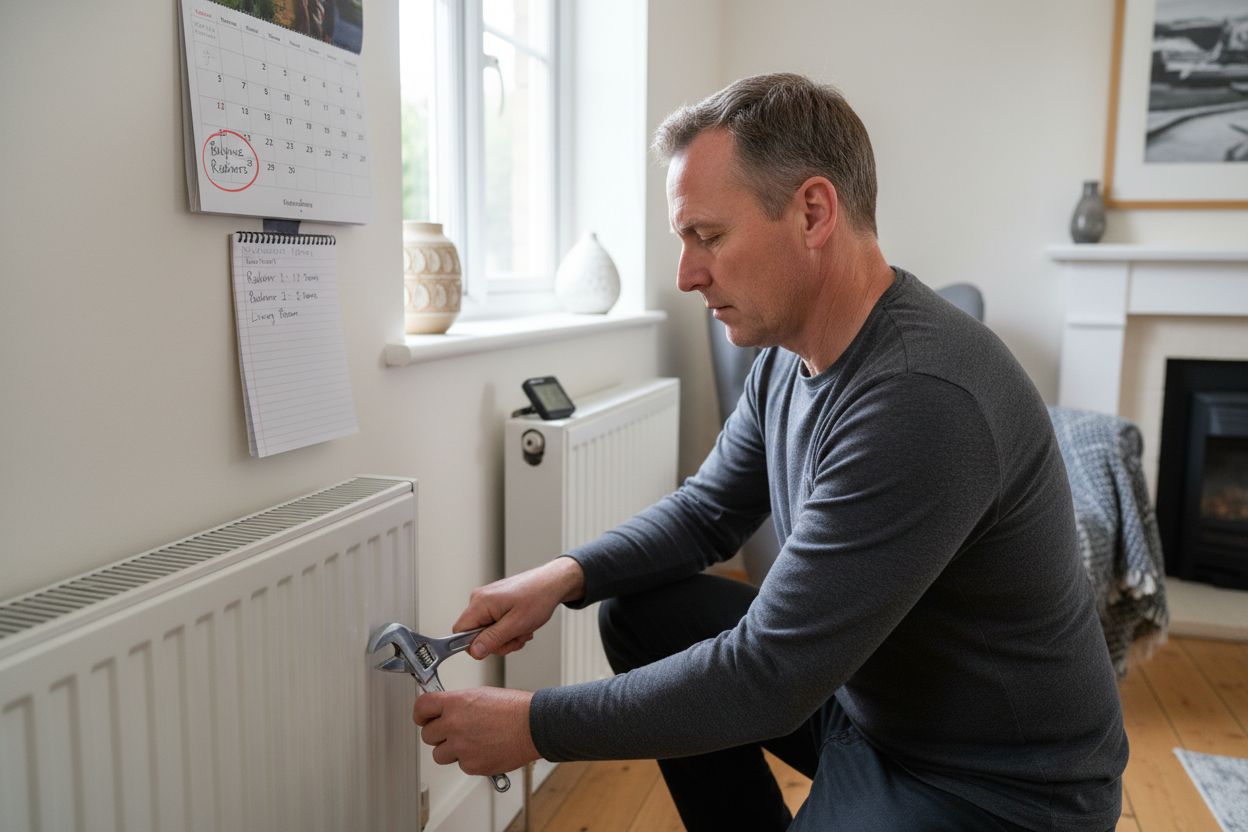
To track your balancing progress effectively, document your findings comprehensively:
![]()
- Initial radiator pipe temperatures
- Lockshield valve starting and final positions
- Temperature differences between inlet and outlet
- Observations about heat distribution in each room
Complete the balancing process by turning your heating system back on and observing performance over several hours. Pay attention to how quickly rooms reach desired temperatures and whether any areas still feel inconsistent. Successful radiator balancing creates a uniform heating experience, reducing energy waste and improving overall home comfort. Your methodical approach transforms an often overlooked maintenance task into a strategic home heating optimization.
Step 5: Test and Verify Heating System Performance
After carefully balancing your heating system, verification becomes the crucial final step to ensure your efforts have produced the desired outcome. This comprehensive testing phase confirms that your adjustments have transformed your home’s thermal environment into an efficiently regulated space.
Systematic testing reveals the true effectiveness of your heating system balance. Begin by running your central heating at full capacity for approximately 30 minutes, allowing sufficient time for thermal stabilization across all rooms. Heating experts recommend thorough performance assessments to validate system modifications. During this test period, use a digital thermometer to measure temperatures in different areas, comparing them against your initial assessment from earlier steps. Note any persistent cold spots or unexpected temperature variations that might indicate remaining balancing challenges.
Pay particular attention to rooms that previously experienced uneven heating. Walk through each space methodically, feeling radiator surfaces and noting temperature consistency. Radiators should warm evenly from bottom to top, with no significant cold zones. If you discover lingering temperature disparities, you may need to readjust lockshield valves or investigate potential obstructions in your system. Sometimes, minor additional tweaks are necessary to achieve optimal performance. Our annual boiler servicing guide offers additional insights into maintaining consistent heating performance.
Documenting your test results provides valuable long-term insights. Create a comprehensive record that captures:
- Room-by-room temperature readings
- Duration of heating cycle
- Boiler performance metrics
- Any observed irregularities
- Comparison with previous system performance
Successful heating system balancing manifests through several key indicators: uniform room temperatures, reduced energy consumption, improved comfort levels, and more consistent heat distribution. If your testing reveals significant discrepancies, do not be discouraged.
Below is a checklist table to help you verify that your heating system balancing has been successful, based on the evidence and outcomes described in the final testing step.
| Verification Step | What to Look For | Indicates Success If… |
|---|---|---|
| System run for 30 minutes | Allow system to stabilise after adjustments | All radiators and rooms have warmed evenly |
| Room-by-room temperature measurements | Use thermometer in each room | Temperatures are consistent, with no major cold spots |
| Radiator surface check | Feel radiators from top to bottom | Radiators are uniformly warm, no significant cold zones |
| Observation of previous problem areas | Pay special attention to formerly cold rooms | Previously cold areas now reach comfort temperature |
| Duration of heating cycle logged | Track how long rooms take to heat up | Heating cycle duration is reduced or optimised |
| Boiler performance noted | Listen for noises, monitor operation | Boiler operates smoothly, no irregularities |
| Documentation and comparison | Compare with initial assessment | Notable improvements are recorded in your log |
Ready to Achieve Perfect Home Comfort and Efficiency?
Are you struggling with uneven heating, fluctuating room temperatures, or a system that never quite feels right? This article on balancing heating systems highlights the real frustrations that come from cold spots, inefficient radiators, and unexpected energy costs. But you do not need to tackle these challenges alone. Expert help is available to bring you lasting comfort and peace of mind.

Turn your knowledge into difference-making action today. The accredited team at Thermatek Heating provides professional heating system balancing, boiler servicing, and smart upgrades for homes across Edinburgh and Midlothian. Our Gas Safe Registered engineers ensure every radiator, valve, and zone of your home is optimised for safety, energy savings, and reliable warmth. If you are ready to replace old components, consider our boiler servicing options or explore cutting-edge heat pump installation for maximum efficiency. Book your free quote today on thermatekheating.co.uk and take the first step towards truly balanced, comfortable living.
Frequently Asked Questions
What is the first step to balance my heating system?
Start by conducting a comprehensive assessment of your current heating system. This includes inspecting radiators, checking temperatures, and examining the boiler and pipework for issues such as corrosion or leaks.
How do I identify problem areas in my home related to heating?
Perform a room-by-room thermal investigation, checking for cold spots and temperature variations. Use tools like an infrared thermometer to measure surface temperatures and identify areas of significant heat loss, such as windows and poorly insulated walls.
Why is it important to check radiator valves and settings?
Radiator valves control heat flow in your home. Properly adjusting them ensures that each room receives adequate warmth, improving comfort and energy efficiency while preventing unnecessary energy waste.
What should I do after balancing my radiators?
After adjusting the radiators, run your heating system at full capacity for about 30 minutes. Measure temperatures in different rooms to verify that your adjustments have achieved uniform heating and make further tweaks if necessary.
Recommended
- Solar Thermal Installers In Edinburgh - Thermatek Heating
- Air Source Heat Pump Installation In Edinburgh - Thermatek Heating
- Central Heating Power Flushing In Edinburgh - Thermatek Heating
- Annual Boiler Servicing In Edinburgh - Thermatek Heating
Understanding Condensing Boiler Benefits for Homeowners
Condensing boilers are quietly changing how homes stay warm and cosy. Some models now offer efficiency ratings up to 95%, which sounds almost too good to be true compared to old boilers that barely hit 70%. Most people think the magic is all about using less gas but the real surprise is how these systems squeeze out extra heat from water vapour that would normally vanish straight up the flue. The science behind that process is nothing short of clever and it makes all the difference to your energy bills and the planet.
Table of Contents
- What Is A Condensing Boiler?
- Why Are Condensing Boilers Important For Homes?
- How Do Condensing Boilers Work?
- Key Advantages Of Condensing Boiler Technology
- Real-World Applications Of Condensing Boilers
Quick Summary
| Takeaway | Explanation |
|---|---|
| Condensing boilers offer high efficiency | They achieve efficiency ratings up to 95%, making them significantly more effective than traditional models. |
| Lower energy bills with better performance | Homeowners can save 25-30% on heating costs compared to conventional boilers due to enhanced fuel efficiency. |
| Reduce carbon emissions significantly | By consuming less fuel, these boilers help lower household carbon footprints, contributing to environmental sustainability. |
| Improved heating consistency and comfort | Condensing boilers provide uniform heat distribution, offering more reliable and comfortable indoor temperatures. |
| Versatile applications for various settings | They are suitable for residential, commercial, and institutional installations, proving their adaptability in diverse environments. |
What is a Condensing Boiler?
A condensing boiler represents a significant advancement in home heating technology, offering homeowners a more efficient and environmentally friendly heating solution. Unlike traditional heating systems, condensing boilers are designed to extract maximum thermal energy from fuel combustion, resulting in substantially improved performance and reduced energy consumption.
Understanding the Core Technology
Condensing boilers work on a sophisticated principle of heat recovery that sets them apart from conventional heating systems. Traditional boilers typically allow substantial heat to escape through exhaust gases, whereas condensing boilers capture and reuse this otherwise wasted thermal energy. By cooling exhaust gases below their dew point, these innovative systems can recover additional heat that would normally be vented outside.
The key mechanism involves a secondary heat exchanger, which allows the boiler to extract latent heat from water vapour in the exhaust gases. As these gases cool and condense, they release extra thermal energy back into the heating system. This process means condensing boilers can achieve efficiency ratings up to 95%, compared to around 70-80% for older, non-condensing models.
Key Benefits of Condensing Boiler Technology
The technological advantages of condensing boilers translate into several significant benefits for homeowners:
- Enhanced Energy Efficiency: Recover up to 25% more heat compared to traditional boilers
- Lower Carbon Emissions: Reduce household carbon footprint through improved fuel utilization
- Reduced Energy Bills: More efficient heat generation leads to lower overall heating costs
According to the Energy Saving Trust, condensing boilers represent a critical technology in reducing domestic energy consumption and supporting broader environmental sustainability goals. By capturing and reusing heat that would traditionally be lost, these systems offer a smart solution for modern, energy-conscious households.
Why are Condensing Boilers Important for Homes?
Condensing boilers have emerged as a transformative solution for homeowners seeking to enhance their property’s energy performance, reduce environmental impact, and manage household heating costs more effectively. These advanced heating systems go beyond traditional approaches, offering a comprehensive strategy for sustainable home energy management.
Financial and Economic Advantages
One of the primary reasons condensing boilers are crucial for modern homes is their significant economic benefits. Homeowners can experience substantial savings on energy expenditure through improved fuel efficiency. By recovering heat that would traditionally be lost through exhaust gases, these systems can reduce energy consumption by up to 25% compared to conventional boilers. This translates directly into lower monthly utility bills and long term financial savings.
Environmental Sustainability Impact
Beyond economic considerations, condensing boilers play a critical role in reducing household carbon emissions. Residential heating accounts for approximately 14% of UK carbon emissions, and by adopting more efficient technologies, homeowners can make meaningful contributions to environmental sustainability. The reduced fuel consumption means fewer greenhouse gases are released, supporting broader climate protection goals.
Performance and Comfort Enhancements
Condensing boilers offer more than just energy efficiency. They provide superior heating performance with several key advantages:
- Consistent Heat Distribution: More uniform temperature across living spaces
- Lower Operating Temperatures: Reduced strain on heating infrastructure
- Advanced Temperature Control: More precise management of home heating
According to Energy Saving Trust, condensing boilers represent a critical technology in modern home energy solutions. Their ability to capture and reuse heat makes them an essential upgrade for homeowners looking to balance economic savings with environmental responsibility.

For those interested in exploring the latest heating technologies, check out our latest news and updates about energy efficient home solutions.
How Do Condensing Boilers Work?
Condensing boilers represent a sophisticated approach to heat generation, utilizing advanced thermodynamic principles to maximize energy efficiency and performance. These systems transform traditional heating methods by capturing and reusing heat that would otherwise be wasted during the combustion process.
The Thermodynamic Process
At the core of a condensing boiler’s functionality is an innovative heat exchange mechanism. When fuel burns, it produces hot gases containing significant thermal energy. Traditional boilers would simply vent these hot gases outside, losing substantial heat. In contrast, condensing boilers feature a secondary heat exchanger that captures and recycles this latent heat energy.
As the hot exhaust gases pass through this secondary exchanger, they cool down and condense, releasing additional heat back into the water circulation system.
This process allows the boiler to extract maximum thermal energy from every unit of fuel, achieving efficiency levels approaching 95%.
Key Operational Components
The sophisticated design of condensing boilers involves several critical components working in precise synchronization:
- Primary Heat Exchanger: Initial heat transfer from combustion
- Secondary Heat Exchanger: Captures condensing gases’ residual heat
- Condensate Pipe: Manages water produced during condensation process
- Flue Gas Sensor: Monitors exhaust temperature and efficiency
According to The Carbon Trust, the condensing process enables these systems to recover heat that would traditionally be lost, representing a significant technological advancement in domestic heating efficiency.
For homeowners considering an upgrade, understanding these technical nuances highlights why condensing boilers are a smart investment in modern home heating technology.
The following table summarises the main differences between condensing boilers and traditional (non-condensing) boilers based on the explanations given in the article.
| Feature | Condensing Boiler | Traditional Boiler |
|---|---|---|
| Efficiency Rating | Up to 95% | Around 70-80% |
| Heat Recovery | Recovers latent heat from water vapour in exhaust gases | Most heat escapes through exhaust gases |
| Carbon Emissions | Significantly reduced | Higher due to more fuel use |
| Energy Bills | Lower (25-30% savings) | Higher due to inefficiency |
| Heat Distribution | More uniform and consistent | Often less consistent |
| Operating Temperature | Can run at lower temperatures | Runs at higher temperatures |
| Key Component | Secondary heat exchanger | Single heat exchanger |
| Check out our latest news for more insights into cutting-edge heating solutions. |
Key Advantages of Condensing Boiler Technology
Condensing boiler technology represents a quantum leap forward in residential heating systems, offering homeowners a comprehensive suite of advantages that extend far beyond traditional heating solutions. These sophisticated systems are engineered to deliver exceptional performance, economic benefits, and environmental sustainability.
Economic and Energy Performance Benefits
The primary advantage of condensing boilers lies in their remarkable energy efficiency. By capturing and reusing heat that would typically be expelled through exhaust gases, these systems can achieve efficiency ratings up to 95%. This means homeowners can potentially reduce their heating expenses by 25-30% compared to conventional boiler models.
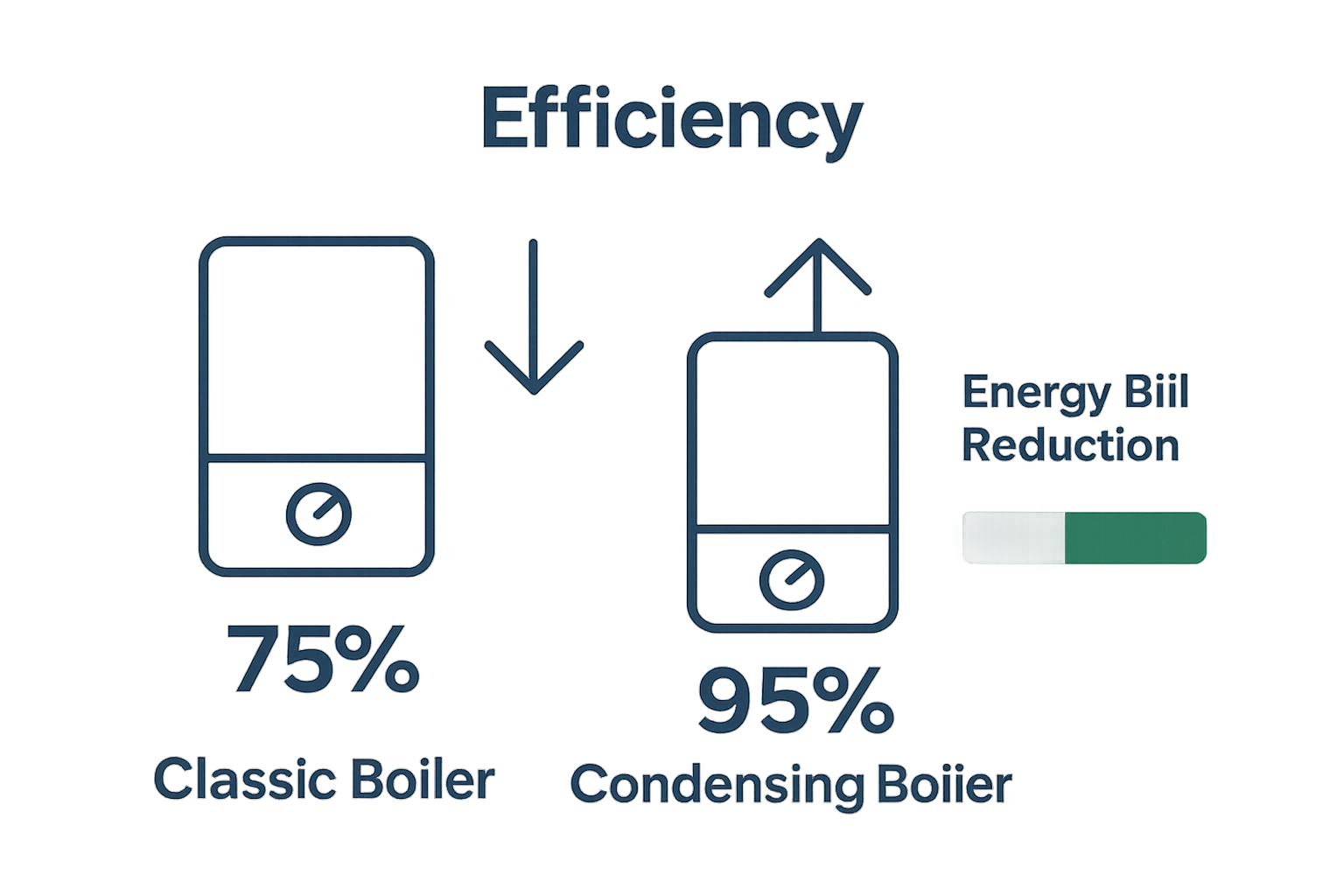 The long-term financial savings make condensing boilers an intelligent investment for households looking to manage energy costs strategically.
The long-term financial savings make condensing boilers an intelligent investment for households looking to manage energy costs strategically.
Environmental Impact and Sustainability
Beyond economic considerations, condensing boilers play a crucial role in reducing carbon emissions and supporting environmental sustainability. Their advanced heat recovery mechanism significantly diminishes the carbon footprint of residential heating systems. By consuming less fuel and generating more heat from the same energy input, these boilers contribute to broader climate protection efforts and help homeowners align with increasingly stringent environmental standards.
Practical Performance Advantages
Condensing boilers offer several practical performance benefits that enhance home comfort and heating reliability:
- Lower Operating Temperatures: Reduces thermal stress on heating infrastructure
- More Uniform Heat Distribution: Provides consistent warmth across living spaces
- Enhanced Temperature Precision: Enables more sophisticated heating management
- Compact Design: Requires less installation space compared to traditional systems
According to Energy Saving Trust, condensing boilers represent a transformative technology in domestic heating, delivering substantial efficiency improvements across residential settings.
For homeowners considering upgrading their heating infrastructure, our boiler replacement service offers expert guidance and installation support for transitioning to these advanced heating technologies.
Real-World Applications of Condensing Boilers
Condensing boilers have transitioned from innovative technology to a standard solution across residential and commercial settings, demonstrating remarkable versatility in addressing diverse heating requirements. Their practical applications extend far beyond theoretical efficiency, providing tangible benefits across multiple environments and usage scenarios.
This table organises the major practical application categories for condensing boilers, providing concise explanations of each real-world scenario discussed in the article.
| Application Category | Description |
|---|---|
| Residential Housing | Standard houses, apartments, multi-unit complexes; ideal for consistent heating and hot water supply |
| Commercial Buildings | Offices, community centres; suited for managing complex and diverse heating requirements |
| Institutional Settings | Schools, hospitals; robust performance and economic benefits in large facilities |
| Retrofit Installations | Upgrading older properties with improved efficiency while utilising existing infrastructure |
| New Construction Projects | Incorporated into energy-efficient modern builds |
| Heritage Property Renovations | Provides modern efficiency without compromising historical architecture |
| Mixed-Use Developments | Addresses a diverse range of simultaneous heating needs |
Residential Housing Applications
In domestic settings, condensing boilers have revolutionized home heating strategies. Typical residential applications include standard houses, apartments, and multi-unit residential complexes. These systems prove particularly effective in properties with consistent heating demands, such as family homes with regular occupancy patterns. They excel in providing uniform heat distribution, managing temperature variations, and delivering consistent hot water supply with exceptional energy efficiency.
Commercial and Institutional Installations
Beyond residential use, condensing boilers have gained significant traction in commercial and institutional environments. Schools, hospitals, office buildings, and community centres increasingly rely on these systems for their robust performance and economic advantages. The ability to manage complex heating requirements while maintaining high efficiency makes condensing boilers an attractive solution for organisations seeking to reduce operational costs and demonstrate environmental responsibility.
Specific Deployment Scenarios
Condensing boilers demonstrate remarkable adaptability across various specific contexts:
- Retrofit Installations: Replacing older, less efficient heating systems in existing buildings
- New Construction Projects: Integral to modern energy-efficient building designs
- Heritage Property Renovations: Providing modern efficiency without compromising architectural integrity
- Mixed-Use Developments: Serving diverse heating requirements in complex environments
According to Energy Saving Trust, condensing boiler technology represents a crucial strategy in national efforts to reduce carbon emissions and improve energy efficiency across residential and commercial sectors.
Our boiler servicing team specialises in supporting these sophisticated heating solutions, ensuring optimal performance across diverse real-world applications.
Unlock the Full Potential of Your Home Heating with Thermatek
Upgrading to a condensing boiler promises energy savings, lower bills, and a smaller carbon footprint, but making the switch can feel daunting when you want trusted advice and safe, professional installation. Many homeowners worry about finding a team who truly understands the local regulations and can deliver on efficiency, reliability, and lasting comfort. With expertise in cutting-edge condensing boilers and a focus on reducing household running costs, Thermatek is here to guide you through every step.

Ready to enjoy modern heating technology backed by expert support? Visit thermatekheating.co.uk to discover our full range of heating solutions. Book your free quote with our Gas Safe Registered engineers and ask about our boiler replacement services and professional boiler servicing. Take the first step and transform your home’s comfort and efficiency today—spaces are limited for priority installation in Edinburgh and Midlothian.
Frequently Asked Questions
What is a condensing boiler?
A condensing boiler is an advanced heating system designed to maximise energy efficiency by recovering and reusing heat that would otherwise be lost in exhaust gases. This technology allows for efficiency ratings of up to 95%.
How do condensing boilers improve energy efficiency compared to traditional boilers?
Condensing boilers can recover up to 25% more heat because they capture latent heat from water vapour in exhaust gases. This results in significantly lower energy consumption and heating costs compared to conventional boilers.
What are the environmental benefits of using a condensing boiler?
Condensing boilers reduce carbon emissions by utilising fuel more efficiently, which leads to less fuel consumption and greenhouse gas emissions, contributing to environmental sustainability and climate protection efforts.
Can condensing boilers provide consistent heat and comfort?
Yes, condensing boilers offer superior heating performance with benefits such as consistent heat distribution, lower operating temperatures, and advanced temperature control, enhancing overall comfort in homes.
Recommended
- New Boiler Installation & Replacement In Edinburgh - Thermatek Heating
- Solar Thermal Installers In Edinburgh - Thermatek Heating
- Annual Boiler Servicing In Edinburgh - Thermatek Heating
- News - Thermatek Heating
Understanding What is Underfloor Heating for Your Home
Underfloor heating turns the idea of home comfort upside down. Most people picture radiators working overtime in one corner, but with underfloor systems, you get even heat distribution across your entire room. The unexpected part is how this shift means not just warmth underfoot but also potential energy savings for years to come.
Table of Contents
- What Is Underfloor Heating And How Does It Work?
- The Importance Of Underfloor Heating In Modern Homes
- Key Benefits Of Underfloor Heating Systems
- Types Of Underfloor Heating: Electric Vs. Water-Based
- Real-World Applications And Considerations For Underfloor Heating
Quick Summary
| Takeaway | Explanation |
|---|---|
| Underfloor heating ensures uniform warmth. | This system heats from the ground up, eliminating cold spots and providing consistent room temperatures throughout. |
| Energy efficiency lowers utility costs. | Underfloor heating operates at lower temperatures, reducing energy consumption and potentially lowering heating bills compared to traditional methods. |
| Two systems: electric and water-based. | Electric systems are easier to install in smaller areas, while water-based systems offer efficiency for larger spaces and whole-home heating. |
| Compatible with renewable energy sources. | This heating solution integrates well with heat pumps and solar energy systems, supporting sustainable living and energy conservation. |
| Enhances property value. | Modern heating solutions like underfloor systems are attractive to buyers, potentially increasing home marketability and value. |
What is Underfloor Heating and How Does it Work?
Underfloor heating represents an innovative home heating solution that transforms how warmth is distributed throughout living spaces. Unlike traditional radiators that heat rooms from specific points, this system provides comprehensive, even heat distribution directly from the floor upwards, creating a comfortable and efficient warming experience.
The Fundamental Mechanics of Underfloor Heating
At its core, underfloor heating operates through two primary technologies: water-based (hydronic) and electric systems. According to the Energy Saving Trust, these systems work by circulating warmth beneath your floor surface, radiating heat uniformly across the entire room.
Water-based systems involve a network of pipes connected to your central heating, circulating warm water underneath the floor. These pipes are typically embedded within screed or fitted beneath floor coverings, creating a consistent thermal layer. Electric systems, conversely, use electrical heating mats or cables woven underneath flooring materials, generating heat through electrical resistance.
Advantages of Radiant Floor Heating
The benefits of underfloor heating extend far beyond traditional heating methods. Key advantages include:
- Uniform Heat Distribution: Unlike radiators that create temperature variations, underfloor heating provides consistent warmth across entire rooms
- Energy Efficiency: By heating directly from the floor, these systems require lower water temperatures compared to conventional radiators
- Space Optimization: Eliminates bulky radiators, freeing wall space for furniture and decoration
- Improved Comfort: Reduces cold spots and drafts, creating a more pleasant living environment
Whether installed in new constructions or retrofitted into existing homes, underfloor heating offers a sophisticated approach to maintaining comfortable indoor temperatures while potentially reducing energy consumption.
To help clarify the main advantages of underfloor heating discussed in the article, the following table offers an at-a-glance overview of its principal benefits and corresponding explanations.
| Benefit | Explanation |
|---|---|
| Uniform Heat Distribution | Consistent warmth across the entire room, eliminating cold spots and temperature variation |
| Energy Efficiency | Operates at lower temperatures, resulting in reduced energy usage and running costs |
| Space Optimisation | Removes need for radiators, freeing wall space and enabling more flexible interior design |
| Improved Comfort | Reduces drafts and provides a more pleasant living environment |
| Lower Maintenance | Fewer moving parts lead to decreased maintenance requirements over time |
| Increased Property Value | Modern and efficient heating solutions enhance home appeal and potential resale value |
The Importance of Underfloor Heating in Modern Homes
As homeowners increasingly seek sustainable and efficient heating solutions, underfloor heating emerges as a transformative technology that goes beyond traditional warming methods. This advanced heating system represents more than just comfort it symbolizes a strategic approach to energy management and home design in contemporary living spaces.
Energy Efficiency and Environmental Considerations
Underfloor heating stands at the forefront of energy-conscious home solutions. According to the Energy Saving Trust, these systems are remarkably compatible with low-carbon heating technologies, supporting broader environmental sustainability goals. By operating at lower water temperatures compared to traditional radiators, underfloor heating significantly reduces energy consumption and supports the UK’s net-zero carbon targets.
Economic and Practical Benefits
Beyond environmental advantages, underfloor heating offers substantial economic benefits for homeowners. The system’s ability to distribute heat evenly means reduced energy wastage and lower utility bills. Moreover, the technology integrates seamlessly with modern heat pump installations, creating a comprehensive heating strategy that maximises both comfort and cost-effectiveness.
Key economic advantages include:
- Lower Operational Temperatures: Requires less energy to maintain comfortable room temperatures
- Reduced Heat Loss: Even heat distribution minimises energy wastage
- Increased Property Value: Modern heating systems are attractive to potential buyers
- Long-term Cost Savings: Lower maintenance and more efficient energy usage
For contemporary homes seeking intelligent heating solutions, underfloor heating represents a sophisticated blend of technological innovation, environmental responsibility, and practical comfort.
Key Benefits of Underfloor Heating Systems
Underfloor heating transcends traditional heating methods by offering a comprehensive suite of advantages that enhance both home comfort and operational efficiency. This innovative heating solution represents a significant leap forward in domestic thermal management, addressing multiple homeowner priorities simultaneously.
Comfort and Thermal Performance
The primary distinguishing feature of underfloor heating is its exceptional thermal comfort. Unlike conventional radiators that create localised heat zones, these systems deliver uniform warmth across entire living spaces. According to the Energy Saving Trust, the radiant heat from floor-level distribution ensures a more consistent and pleasant temperature experience, eliminating cold spots and reducing drafts.
Energy Efficiency and Cost Savings
Modern homeowners increasingly prioritise energy-efficient solutions, and underfloor heating excels in this domain. By operating at lower water temperatures and providing more direct heat transfer, these systems can significantly reduce energy consumption. The uniform heat distribution means less energy is required to maintain comfortable room temperatures, translating into potential long-term cost savings. Additionally, integrating these systems with solar thermal installations can further enhance overall home energy efficiency.
Key performance advantages include:
- Lower Running Costs: Reduced energy consumption compared to traditional heating systems
- Improved Heat Retention: Better thermal mass and more consistent heat spread
- Compatibility with Renewable Technologies: Works effectively with heat pumps and solar energy systems
- Reduced Carbon Footprint: Supports sustainable home heating strategies
Beyond immediate comfort, underfloor heating represents a forward-thinking approach to home thermal management, combining technological innovation with practical energy conservation principles.
Types of Underfloor Heating: Electric vs. Water-Based
Underfloor heating technology offers homeowners two primary system configurations: electric and water-based solutions. Each approach delivers radiant warmth but differs significantly in installation, operational mechanics, and suitability for various home environments.
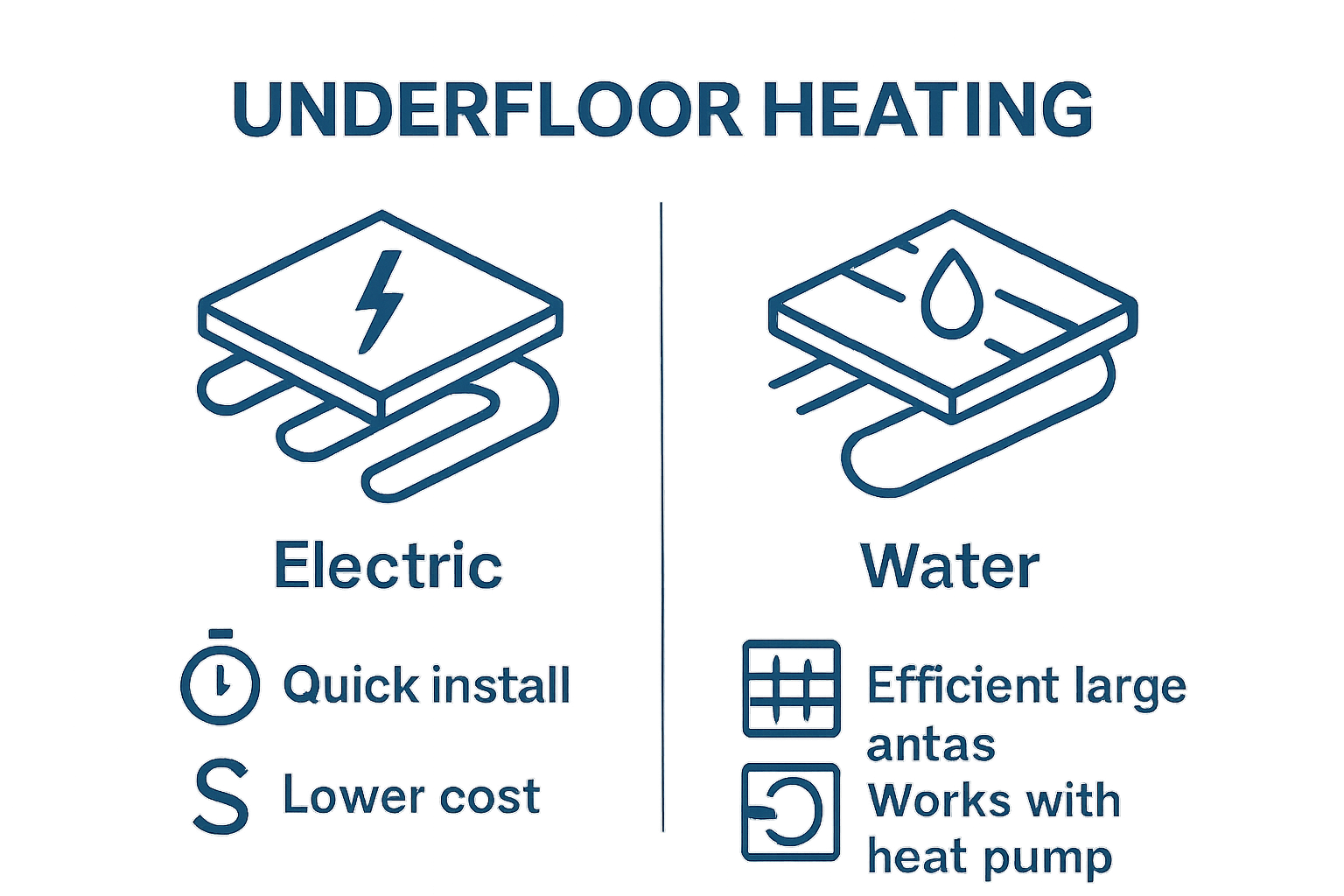
Electric Underfloor Heating Systems
Electric underfloor heating utilises thin heating cables or pre-configured mats installed directly beneath floor surfaces. According to the Energy Saving Trust, these systems are particularly well-suited for smaller spaces like bathrooms, kitchens, and individual rooms where retrofitting complex pipework might be challenging.
Key characteristics of electric systems include:
- Quick Installation: Easier and faster to implement compared to water-based systems
- Lower Upfront Costs: Less expensive initial investment
- Ideal for Renovation: Minimal floor height disruption
- Precise Temperature Control: Independent room-by-room heating management
Water-Based (Hydronic) Underfloor Heating
Water-based systems represent a more comprehensive heating solution, involving a network of pipes connected to your central heating system. These networks circulate warm water underneath the floor, creating a consistent thermal layer. While more complex to install, they offer superior efficiency for larger living spaces and whole-home heating strategies. Stay updated with our latest heating technologies to understand evolving installation techniques.
Distinctive features of water-based systems include:
- Higher Energy Efficiency: Lower operational temperatures
- Whole-Home Heating: Suitable for extensive coverage
- Long-Term Cost Savings: More economical for larger areas
- Better Integration: Works seamlessly with heat pumps and renewable energy systems
Choosing between electric and water-based underfloor heating depends on specific home requirements, existing infrastructure, budget considerations, and long-term heating objectives.
For readers comparing underfloor heating systems, the table below summarises the key differences between electric and water-based systems, focusing on installation, suitability, and operational advantages.
| Feature / Characteristic | Electric Underfloor Heating | Water-Based (Hydronic) Underfloor Heating |
|---|---|---|
| Installation Complexity | Simple and quick | Involves more complex pipework |
| Typical Areas of Use | Small spaces (bathrooms, kitchens) | Larger spaces or whole-home heating |
| Upfront Cost | Lower | Higher |
| Floor Height Disruption | Minimal | Moderate to significant |
| Running Cost | Generally higher for larger areas | More economical for extensive coverage |
| Temperature Control | Precise, room by room | Centralised, but can be zoned |
| Best Integration | Retrofits and renovations | New builds and major refurbishments |
| Compatibility with Renewables | Compatible with solar, heat pumps | Excellent for integration with heat pumps |
Real-World Applications and Considerations for Underfloor Heating
Underfloor heating transcends traditional heating solutions by offering versatile applications across diverse residential and commercial environments. Understanding its practical implementation requires careful evaluation of structural, architectural, and environmental factors that influence system performance and effectiveness.
Suitable Spaces and Installation Scenarios
Underfloor heating proves adaptable across multiple settings, from compact apartments to expansive family homes. According to the Energy Saving Trust, these systems work effectively with various floor coverings, including tiles, stone, laminate, and engineered wood. However, careful floor construction remains critical to maximising thermal efficiency.
Key installation considerations include:
- Floor Height and Construction: Adequate floor depth for pipe or cable embedding
- Existing Subfloor Conditions: Level and well-insulated surfaces
- Room Functionality: Different requirements for living spaces, bathrooms, and kitchens
- Thermal Insulation: Critical for maintaining heat retention and system efficiency
Performance and Compatibility Factors
Modern underfloor heating systems demonstrate remarkable compatibility with contemporary home design and renewable energy technologies. Explore our heat pump installation services to understand how these systems can integrate seamlessly with advanced thermal management strategies.
Critical performance parameters encompass:
- Temperature Range: Optimal operating temperatures for different room types
- Heating Response Time: Quick and efficient thermal distribution
- Energy Consumption: Comparative efficiency against traditional heating methods
- Maintenance Requirements: Long-term system reliability and performance
By carefully assessing these multifaceted considerations, homeowners can design underfloor heating solutions that provide consistent comfort, energy efficiency, and aesthetic flexibility across diverse living environments.
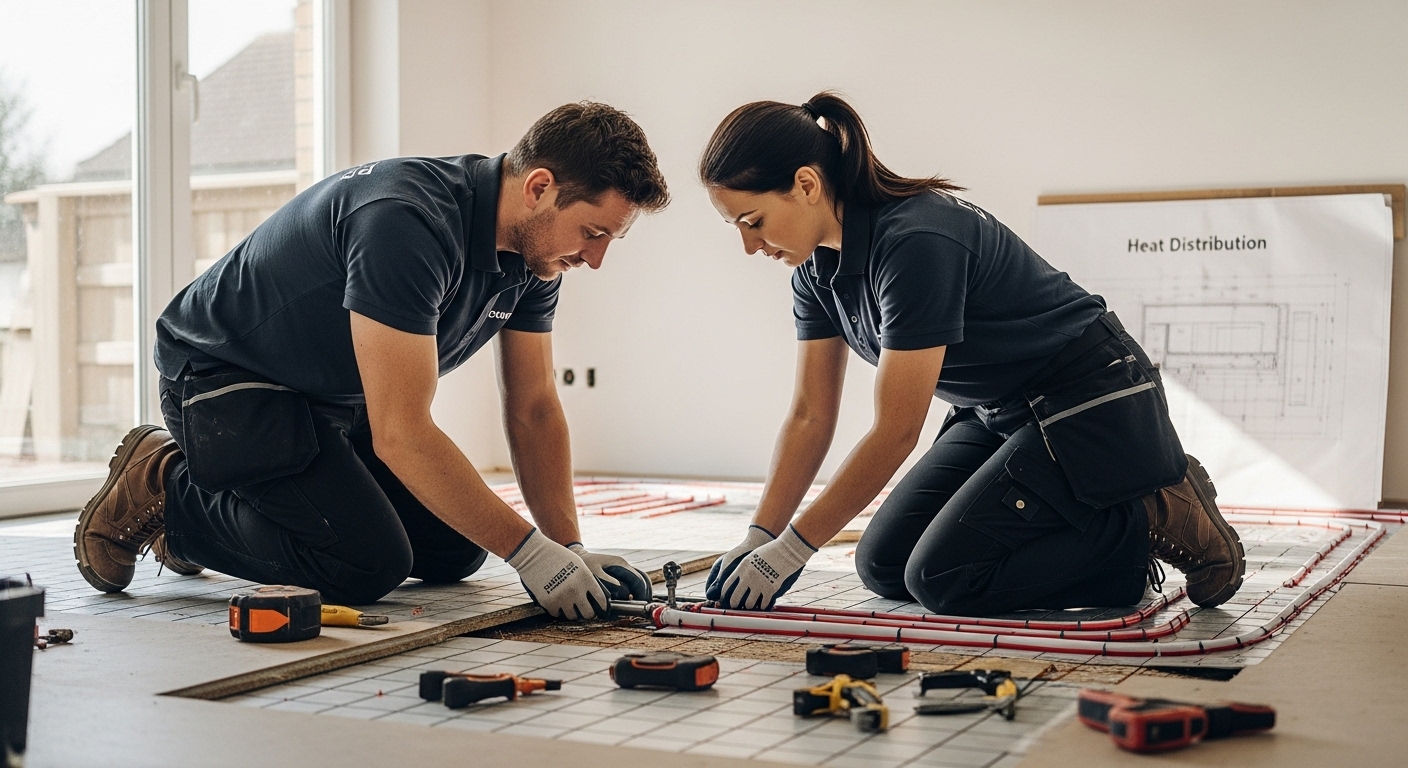
Discover Real Comfort and Efficiency with Thermatek Underfloor Heating
Are you tired of cold spots, rising energy bills, and bulky radiators taking up precious space? The article has shown how underfloor heating can transform your home with even warmth and impressive energy savings. At Thermatek, we turn that knowledge into action, providing expertly installed underfloor heating systems tailored for Edinburgh and Midlothian homes. Our Gas Safe Registered team ensures seamless integration with your current plumbing and heating, so you can enjoy consistent comfort, lower running costs, and a sleek, modern finish. Find out how underfloor heating works in practice and see the difference it can make to your home.

Ready to experience an energy-efficient home that meets today’s standards for comfort and savings? Contact Thermatek’s specialists for a free quote and see why local homeowners trust us for reliable heating solutions. Take control of your indoor comfort today – visit our site or request your consultation now and step into warmth, efficiency, and peace of mind.
Frequently Asked Questions
What is underfloor heating?
Underfloor heating is a modern heating solution that distributes heat evenly from the floor upwards, providing comfort and efficient warmth throughout living spaces.
How does underfloor heating work?
Underfloor heating works through either water-based (hydronic) systems that circulate warm water through pipes beneath the floor or electric systems that use heating mats or cables to generate heat from electrical resistance.
What are the advantages of installing underfloor heating in my home?
Key advantages include uniform heat distribution, energy efficiency, space optimisation, and improved comfort through reduced cold spots and drafts.
What are the differences between electric and water-based underfloor heating systems?
Electric systems use heating cables or mats for quick installation and are suitable for smaller spaces, while water-based systems involve a network of pipes for more comprehensive heating and are ideal for larger areas. Electric systems are generally easier to install, while water-based systems offer better efficiency for whole-home heating.
Recommended
- News - Thermatek Heating
- Air Source Heat Pump Installation In Edinburgh - Thermatek Heating
- Central Heating Power Flushing In Edinburgh - Thermatek Heating
- Solar Thermal Installers In Edinburgh - Thermatek Heating
Complete Guide to Annual Gas Safety Checks for Edinburgh Homes
Every Edinburgh home with gas appliances rests on an invisible safety net. Many assume gas systems just quietly keep us warm, but actually more than 60% of home gas-related incidents arise from unchecked appliances or skipped inspections. So while yearly checks might sound routine, a single thorough inspection can be the difference between security and unexpected danger.
Table of Contents
- Step 1: Assess Your Property’s Gas Appliances
- Step 2: Schedule A Visit With A Certified Engineer
- Step 3: Prepare Your Property For The Inspection
- Step 4: Conduct The Gas Safety Check With The Engineer
- Step 5: Review The Safety Certificate And Recommendations
Quick Summary
| Key Point | Explanation |
|---|---|
| 1. Conduct a thorough inventory of gas appliances | Catalog all gas appliances by location, type, and condition to prepare for inspections and maintenance. |
| 2. Choose a qualified Gas Safe Registered engineer | Verify the engineer’s credentials to ensure compliance with legal safety standards and quality service. |
| 3. Clear access for the inspection | Remove obstacles from around gas appliances to facilitate a smooth and efficient safety check. |
| 4. Review the safety certificate carefully | Examine the inspection report for appliance conditions, recommendations, and compliance status, ensuring understanding of any necessary actions. |
| 5. Schedule future inspections proactively | Mark the next inspection date in your calendar to maintain safety and prevent any compliance issues. |
Step 1: Assess Your Property’s Gas Appliances
Beginning your annual gas safety check requires a systematic approach to identifying and cataloguing all gas appliances within your Edinburgh property. This crucial first step ensures comprehensive safety evaluation and prepares you for a thorough professional inspection.
Start by walking through your entire property and making a detailed inventory of every gas appliance. This includes your boiler, gas cooker, gas fires, gas water heaters, and any other gas-powered equipment. Pay special attention to less obvious locations like utility rooms, kitchen areas, and even secondary spaces such as conservatories or attached garages where gas appliances might be installed.
Key Equipment to Identify and Document:
- Boiler system
- Central heating radiators connected to gas supply
- Gas cookers and hobs
- Freestanding or wall-mounted gas fires
- Gas water heaters
- Outdoor gas equipment
While documenting these appliances, note their approximate age, manufacturer details, and current visible condition. Look for signs of wear such as rust, corrosion, or unusual discolouration around connections and surfaces. For landlords managing rental properties, our comprehensive guide on landlord gas safety certificates provides additional insights into legal requirements and documentation standards.
Accurate record-keeping is essential. Create a spreadsheet or dedicated document listing each appliance with its specific location, model number, installation date, and any previous maintenance records. This documentation not only assists the Gas Safe Registered engineer during the inspection but also helps track the overall condition and potential replacement needs of your gas systems.
Pay particular attention to older appliances, which might require more rigorous examination. Gas appliances over ten years old often need more comprehensive safety assessments. If you notice any immediate concerns like unusual sounds, irregular flame colours, or visible damage, make a specific note to discuss these with your professional inspector.
Remember, a meticulous initial assessment sets the foundation for a successful annual gas safety check. By carefully identifying and documenting all gas appliances, you’re taking a proactive step towards maintaining a safe and efficient heating environment in your Edinburgh home.
Step 2: Schedule a Visit with a Certified Engineer
Scheduling a professional gas safety inspection is a critical step in ensuring the safety and compliance of your Edinburgh property. This process requires careful selection of a Gas Safe Registered engineer who can thoroughly evaluate your property’s gas appliances and systems.
Begin by researching local heating and plumbing companies that specialize in gas safety inspections. Prioritize engineers who are not only registered with the Gas Safe Register but also have extensive experience working with residential properties in the Edinburgh area. Verify the engineer’s credentials by asking to see their official Gas Safe ID card, which should clearly display their unique licence number and the specific types of gas work they are qualified to perform.
Essential Verification Points for Gas Safe Engineers:
- Current Gas Safe Registration
- Specific qualifications for your type of gas appliances
- Professional indemnity insurance
- Local references or customer testimonials
- Experience with Edinburgh property configurations
When contacting potential engineers, provide them with the comprehensive inventory of gas appliances you compiled during your initial property assessment. This detailed information allows them to allocate appropriate time and prepare specific diagnostic equipment for your inspection. Our landlord gas safety certificates service can provide additional guidance on what engineers typically require for a thorough examination.
According to Health and Safety Executive regulations, it is a legal requirement that all gas safety checks are conducted by a qualified professional. During the scheduling process, discuss the expected duration of the inspection, which typically ranges between 60 to 90 minutes depending on the number and complexity of your gas appliances.
Request a formal written quote that outlines the scope of the inspection, including detailed costs and any potential additional charges for complex assessments or potential repairs. Confirm the engineer’s availability and try to schedule the inspection during a time when you or a responsible representative can be present to provide access and answer any questions.
Prepare your property for the inspection by ensuring clear access to all gas appliances, removing any obstructions, and having relevant documentation such as previous service records readily available. This proactive approach demonstrates your commitment to safety and helps the engineer conduct a more efficient and comprehensive assessment.
By carefully selecting a certified engineer and preparing thoroughly, you are taking a significant step towards maintaining a safe and compliant gas system in your home.
Step 3: Prepare Your Property for the Inspection
Preparing your Edinburgh property for a comprehensive gas safety inspection requires meticulous attention to detail and a proactive approach. This crucial step ensures the engineer can conduct a thorough and efficient assessment of your gas systems without unnecessary delays or complications.
Begin by creating a clear pathway to all gas appliances throughout your property. This means moving furniture, removing stored items, and ensuring unobstructed access to boilers, gas fires, cookers, and any other gas-powered equipment. Pay special attention to hard-to-reach areas like airing cupboards, utility rooms, and spaces behind large furniture pieces where gas connections might be located.
Key Preparation Areas:
- Clear access to boiler and heating systems
- Unobstructed gas meter locations
- Removal of items blocking gas appliances
- Ensuring good lighting in inspection areas
- Preparing documentation and previous service records
Our comprehensive landlord gas safety certificates guide recommends gathering all relevant documentation before the engineer arrives. Collect previous maintenance records, installation certificates, and any correspondence related to your gas appliances. These documents provide valuable context and help the engineer understand the history of your property’s gas systems.
According to Gas Safe Register guidelines, homeowners should also ensure good ventilation in the areas to be inspected. Open windows or doors to provide adequate airflow, which helps the engineer work comfortably and can assist in any necessary diagnostic procedures.
If you have pets, make arrangements to keep them in a separate room or area during the inspection. This prevents potential disruptions and ensures the engineer can work safely and without unnecessary distractions. Similarly, if you have children, explain the importance of the inspection and the need to stay clear of the work areas.
Take time to note any specific concerns or unusual behaviors you’ve observed with your gas appliances. Have you noticed strange sounds, irregular flame colors, or unexplained energy consumption? These observations can provide crucial insights for the engineer and help identify potential issues before they become serious problems.
Finally, ensure you or a responsible representative will be present during the entire inspection. This allows you to ask questions, understand the engineer’s findings in real-time, and immediately address any recommendations or concerns that may arise during the safety check. By thoroughly preparing your property, you’re demonstrating a commitment to safety and proactive home maintenance.
Below is a checklist table to help ensure your Edinburgh property is fully prepared before a gas safety inspection.
| Preparation Task | Purpose | Completed (Yes/No) |
|---|---|---|
| Clear pathway to all gas appliances | Allows engineer easy access for a thorough inspection | |
| Remove obstructions from gas meters | Prevents delays and ensures thorough meter examination | |
| Provide good lighting in work areas | Helps engineer conduct efficient and accurate assessment | |
| Gather previous service records | Offers background and makes inspection more efficient | |
| Ensure ventilation in rooms | Promotes safe working conditions and aids diagnostics | |
| Secure pets in another room | Prevents distractions and ensures safety during inspection | |
| Note concerns or unusual behaviour | Alerts engineer to potential existing issues |
Step 4: Conduct the Gas Safety Check with the Engineer
The actual gas safety inspection is a critical moment where professional expertise meets your property’s specific requirements. As the engineer arrives, be prepared to provide a comprehensive overview of your property’s gas systems and any concerns you’ve noticed since the last inspection.
Key Inspection Components:
- Visual examination of all gas appliances
- Operational performance testing
- Flue and ventilation assessment
- Comprehensive safety checks
- Detailed documentation of findings
Expect the engineer to conduct a systematic examination of each gas appliance. They will inspect connections, assess the integrity of pipework, check flame patterns, and evaluate overall operational safety. The engineer will use specialized diagnostic equipment to measure gas pressure, carbon monoxide levels, and ensure each appliance functions within manufacturer specifications.
Our annual boiler servicing guide highlights the importance of allowing the engineer sufficient time to perform a thorough evaluation. During the inspection, they will likely run each appliance through its full operational cycle, checking for consistent performance and identifying any potential issues that might compromise safety.
According to Gas Safe Register procedures, the engineer will provide a detailed report documenting their findings. Pay close attention to this documentation, as it will outline the current condition of your gas systems, any recommended repairs or replacements, and a comprehensive safety assessment.
Be an active participant during the inspection. Ask questions about the process, seek clarification on technical aspects, and request explanations for any identified concerns. Professional engineers appreciate engaged homeowners who are genuinely interested in understanding the safety of their property’s gas systems.
The engineer will also check ventilation around gas appliances, ensuring proper air circulation and identifying any potential blockages or risks. They will assess the condition of flues, checking for corrosion, blockages, or potential carbon monoxide escape routes. This meticulous examination goes beyond a simple visual inspection, utilizing sophisticated detection equipment to ensure your property meets the highest safety standards.
At the conclusion of the inspection, request a comprehensive walkthrough of their findings. Understand any recommended actions, potential repair needs, and the overall health of your gas systems. The goal is not just compliance, but ensuring the long-term safety and efficiency of your Edinburgh home’s heating infrastructure.
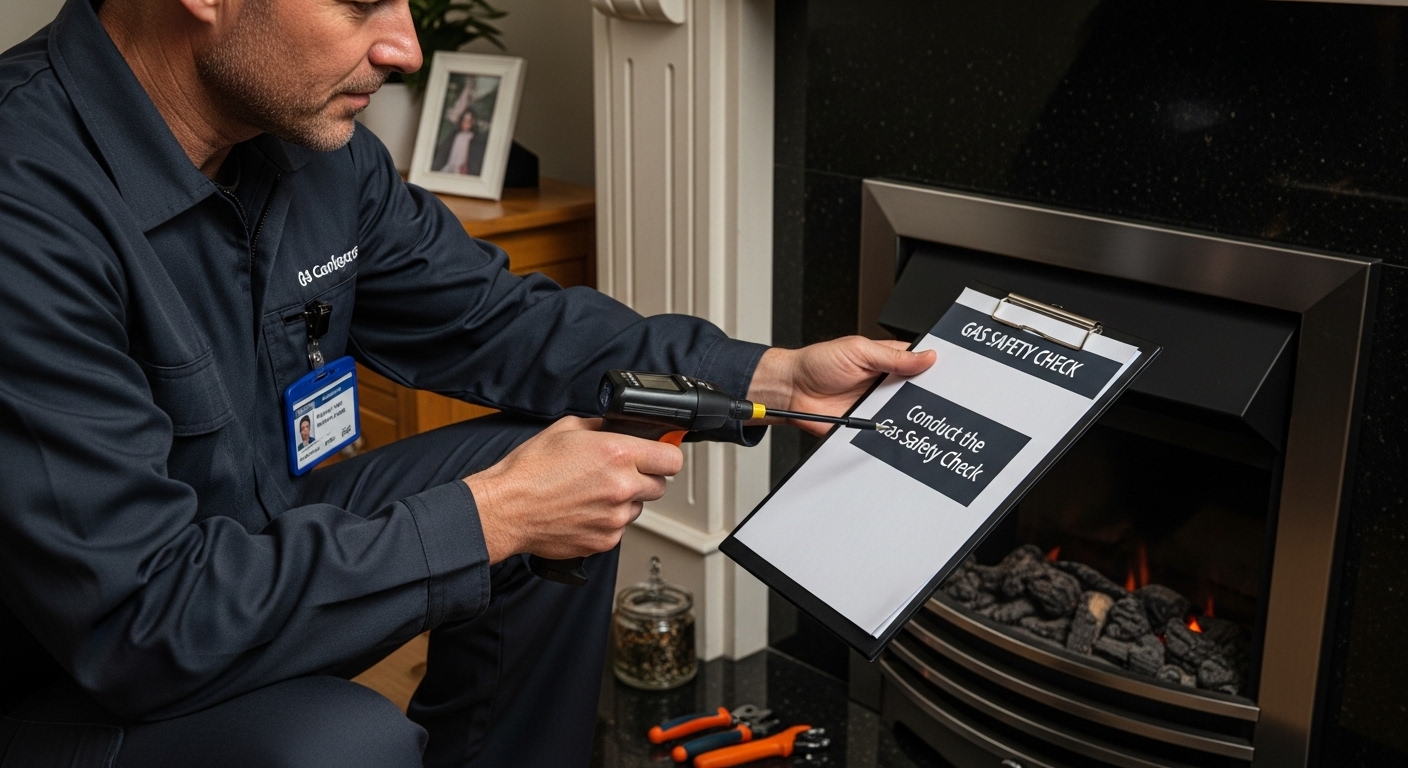
Step 5: Review the Safety Certificate and Recommendations
The gas safety certificate represents the culmination of your annual inspection, providing a comprehensive snapshot of your property’s gas system health. This critical document requires careful and methodical review to ensure you fully understand its implications and any necessary follow-up actions.
Critical Elements to Examine:
- Detailed appliance inspection results
- Safety test measurements
- Potential repair recommendations
- Compliance status
- Next recommended inspection date
Immediately after receiving the certificate, set aside dedicated time to review each section meticulously. Look for specific details about each gas appliance, including its current condition, operational performance, and any identified potential risks. Pay particular attention to any recommendations for repairs or replacements, as these could indicate underlying issues that require prompt attention.
Our annual boiler servicing guide emphasizes the importance of understanding technical details within the certificate. If any technical language or measurements seem unclear, do not hesitate to contact the engineer directly for clarification. Professional engineers are typically happy to explain their findings in more accessible terms.
According to Health and Safety Executive regulations, landlords must retain these certificates for at least two years and provide copies to tenants within 28 days of the inspection. Even if you are a homeowner, maintaining a comprehensive record of these documents is crucial for tracking your property’s maintenance history and potential future repair needs.
Create a dedicated file or digital folder to store your gas safety certificates, organizing them chronologically. This systematic approach allows you to track the long-term performance and maintenance of your gas systems. Include not just the current certificate, but also previous inspection reports, which can help identify recurring issues or track the effectiveness of past repairs.
Should the certificate recommend any repairs or further investigations, prioritize these actions immediately. Delaying recommended repairs can compromise both safety and the efficiency of your gas appliances. Contact a qualified engineer to address these recommendations promptly, ensuring your property remains safe and compliant.
Finally, mark the next recommended inspection date in your calendar. Proactive scheduling prevents last-minute rushes and ensures continuous safety monitoring. By treating the gas safety certificate as more than just a bureaucratic document, you’re taking a responsible approach to maintaining your Edinburgh home’s heating infrastructure.
The table below summarises the critical elements to review on your gas safety certificate, ensuring you capture essential follow-up actions after each inspection.
| Certificate Section | What to Check For | Immediate Action Needed (Yes/No) |
|---|---|---|
| Appliance Inspection Results | Condition and operational details for each appliance | |
| Safety Test Measurements | Recorded pressure, emissions, and compliance values | |
| Repair Recommendations | Any suggested repairs, replacements, or further investigations | |
| Compliance Status | Whether property passes all required safety standards | |
| Next Inspection Date | Recommended date for next appointment |
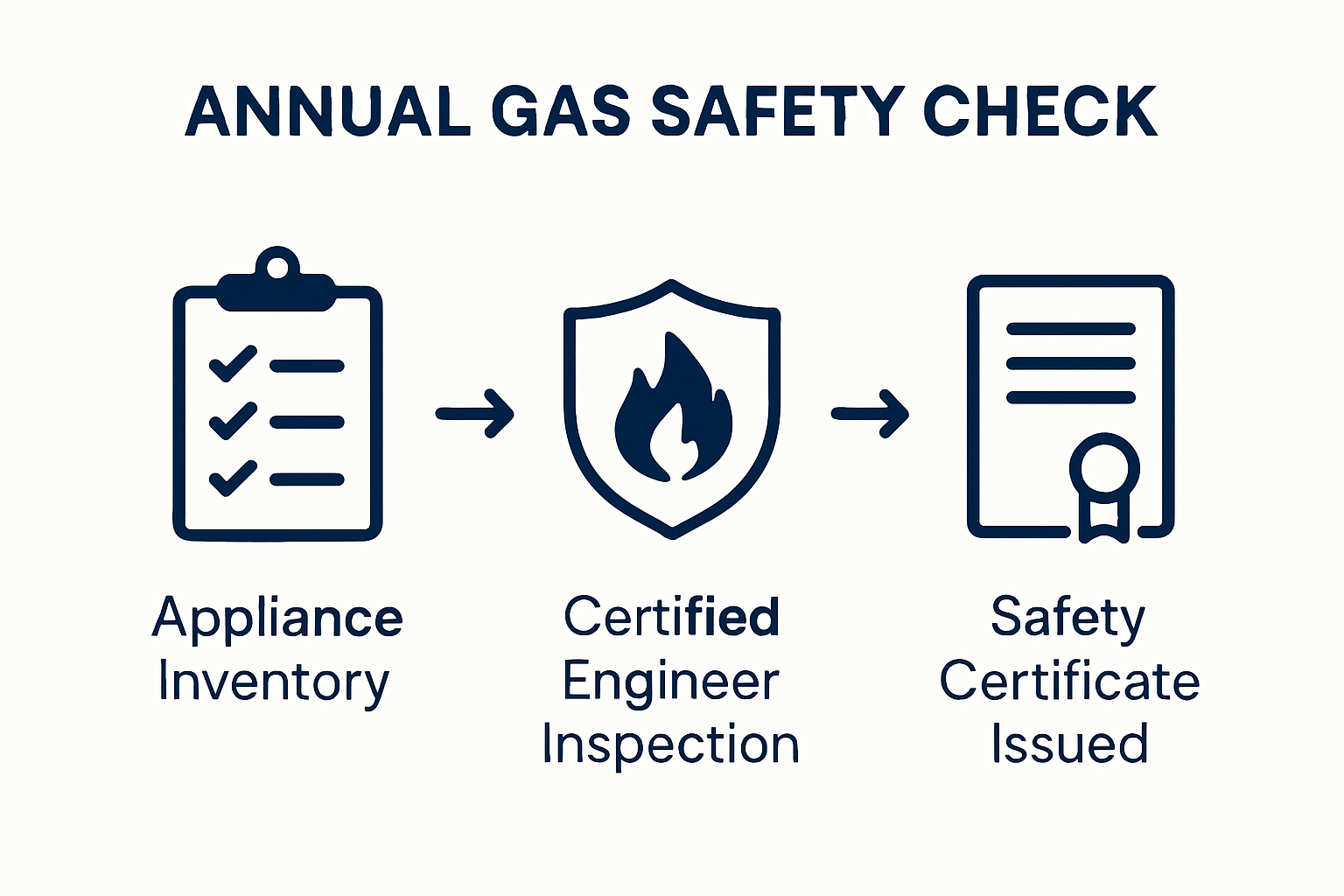
Protect Your Edinburgh Home with Trusted Annual Gas Safety Expertise
Staying compliant with annual gas safety checks can feel overwhelming, especially when you are responsible for boilers, gas cookers and heating systems that keep your home running smoothly. This guide has shown how missing even one key step could put your family or tenants at risk and lead to costly problems. Thermatek understands the stress of navigating regulations and the deep need for trustworthy, qualified help. That is why our team of friendly Gas Safe Registered engineers are committed to making your annual inspection thorough, honest and stress-free.

Do not leave the safety of your property to chance. Book your inspection or maintenance today and let us handle all the details, from professional assessments to official certification. Learn more and request your free, no-obligation quote on the Thermatek Heating website. Rely on our proven boiler servicing solutions or discover how we support landlords with gas safety checks. Act now before small issues become bigger risks—trust Thermatek for a safer and more efficient home.
Frequently Asked Questions
What should I include in my gas appliance inventory for the safety check?
Make a detailed list of all gas appliances, including the boiler, gas cooker, gas fires, and gas water heaters. Document their age, manufacturer details, and current condition, noting any signs of wear or damage.
How do I find a qualified engineer for my gas safety inspection?
Research local heating and plumbing companies that specialise in gas safety. Ensure the engineer is registered with the Gas Safe Register and has experience with residential properties. Always ask to see their Gas Safe ID card for verification.
What preparations should I make before the gas safety inspection?
Clear access to all gas appliances, ensuring no obstructions block the engineer’s path. Gather relevant documentation such as previous service records and ensure good ventilation in the inspection areas.
What does the gas safety check involve?
The inspection includes a visual examination of all gas appliances, performance testing, and checks for flue and ventilation. The engineer will document their findings and provide recommendations for any necessary repairs or improvements.
Recommended
- Landlord Gas Safety Certificates In Edinburgh - Thermatek Heating
- Annual Boiler Servicing In Edinburgh - Thermatek Heating
- New Boiler Installation & Replacement In Edinburgh - Thermatek Heating
- News - Thermatek Heating

